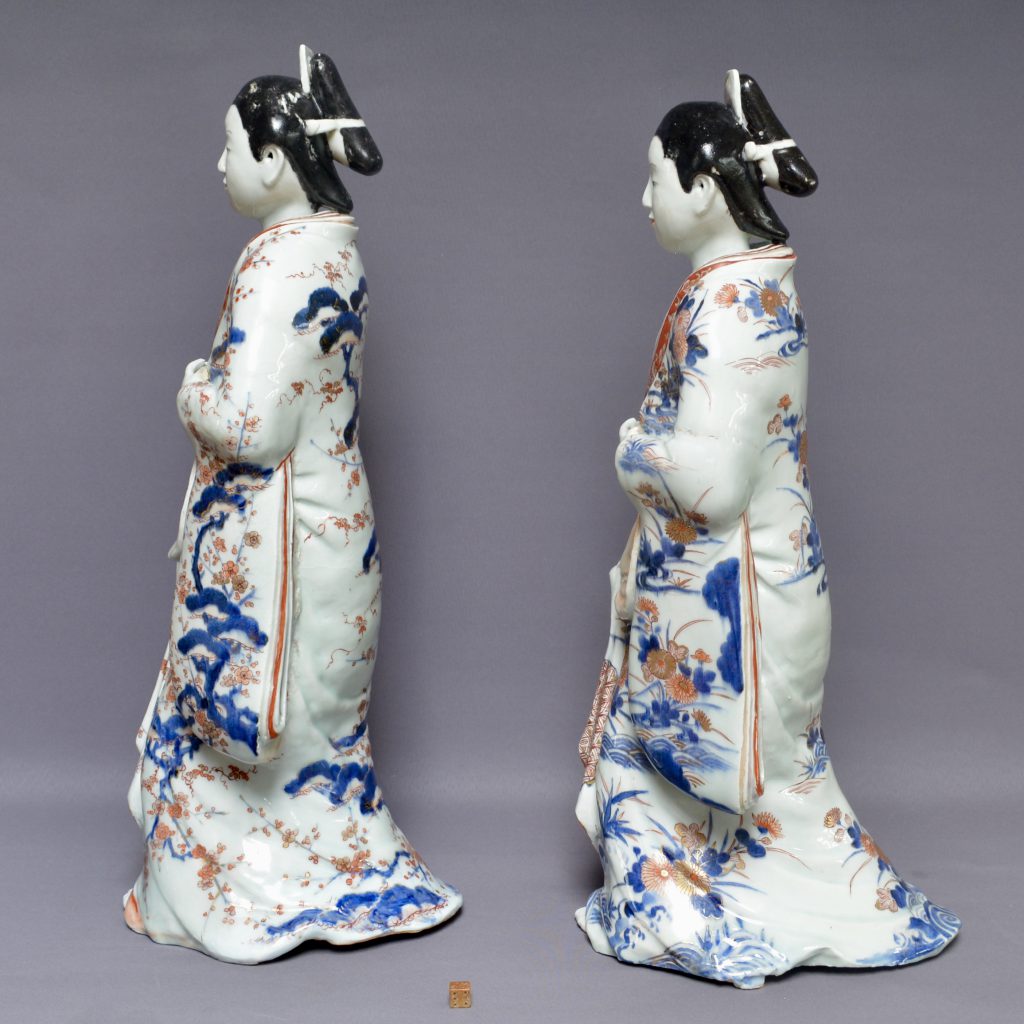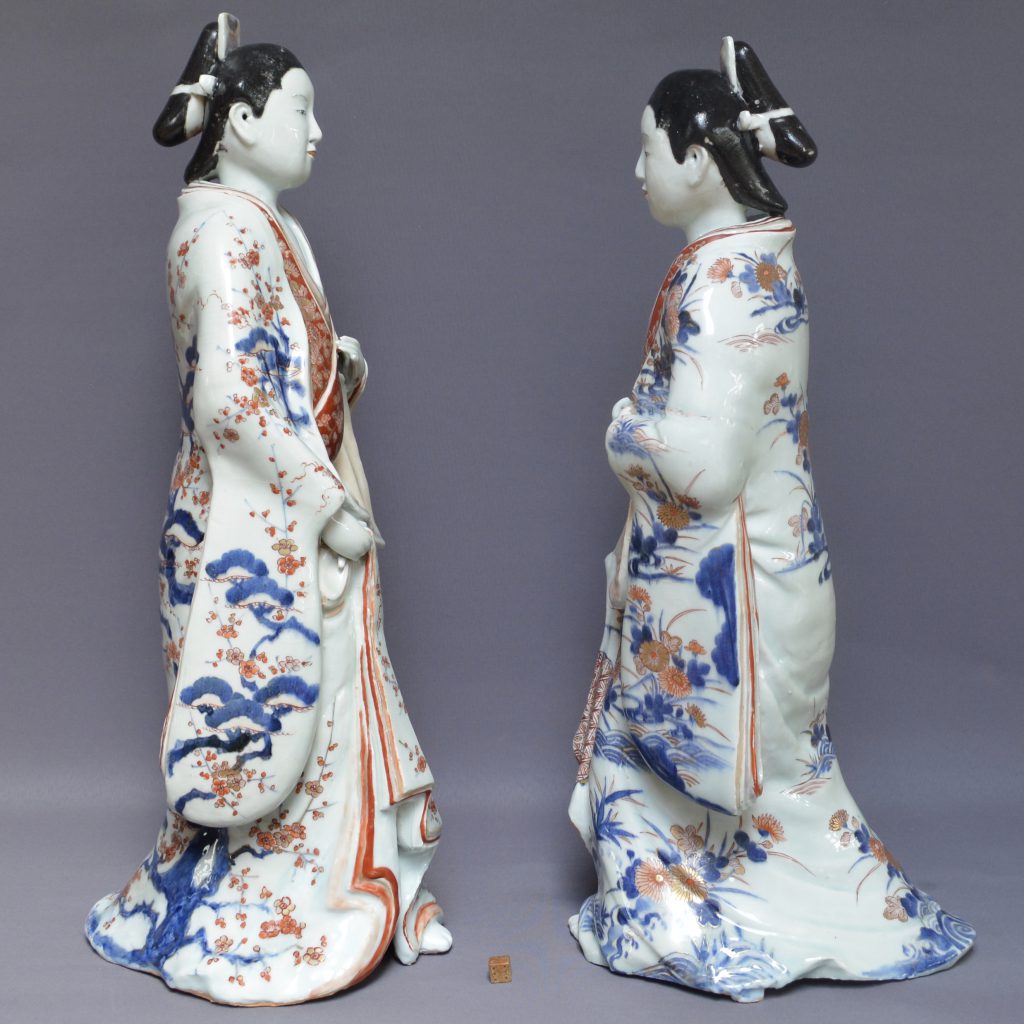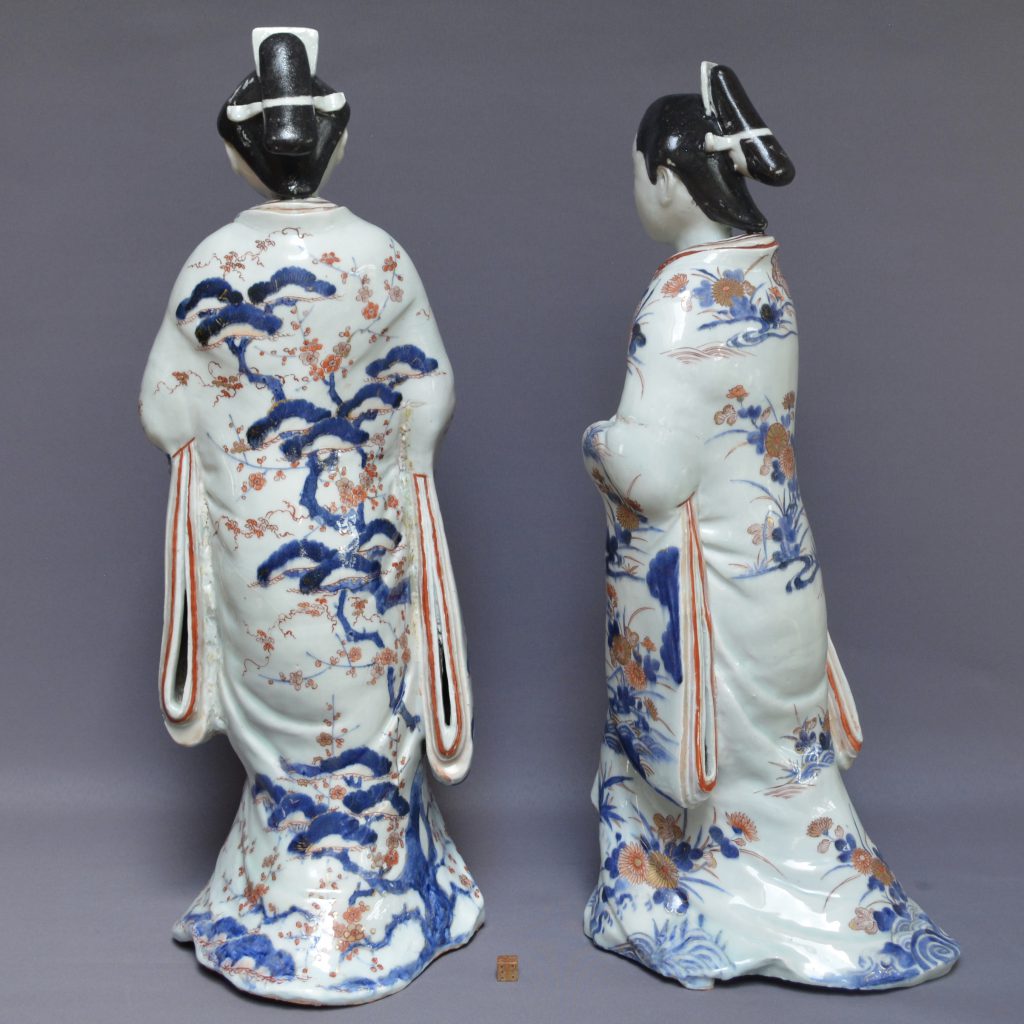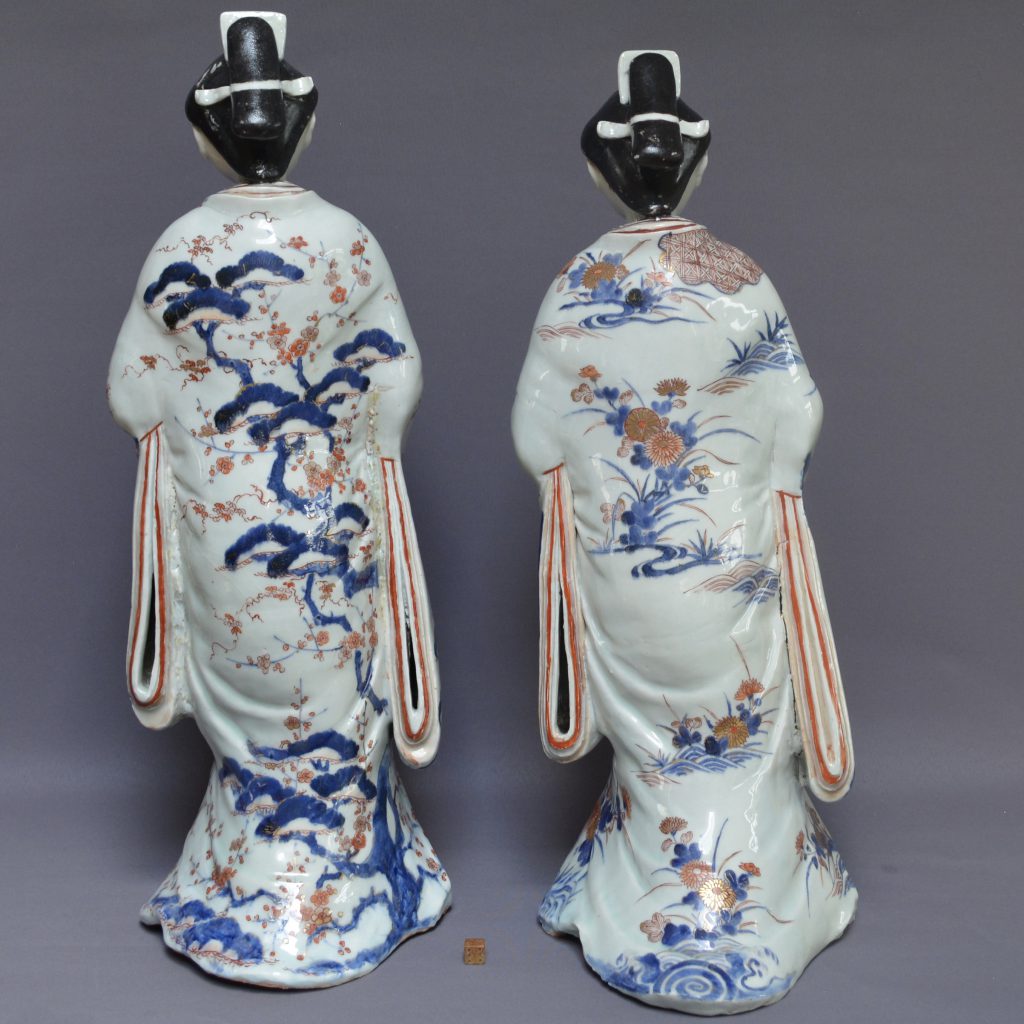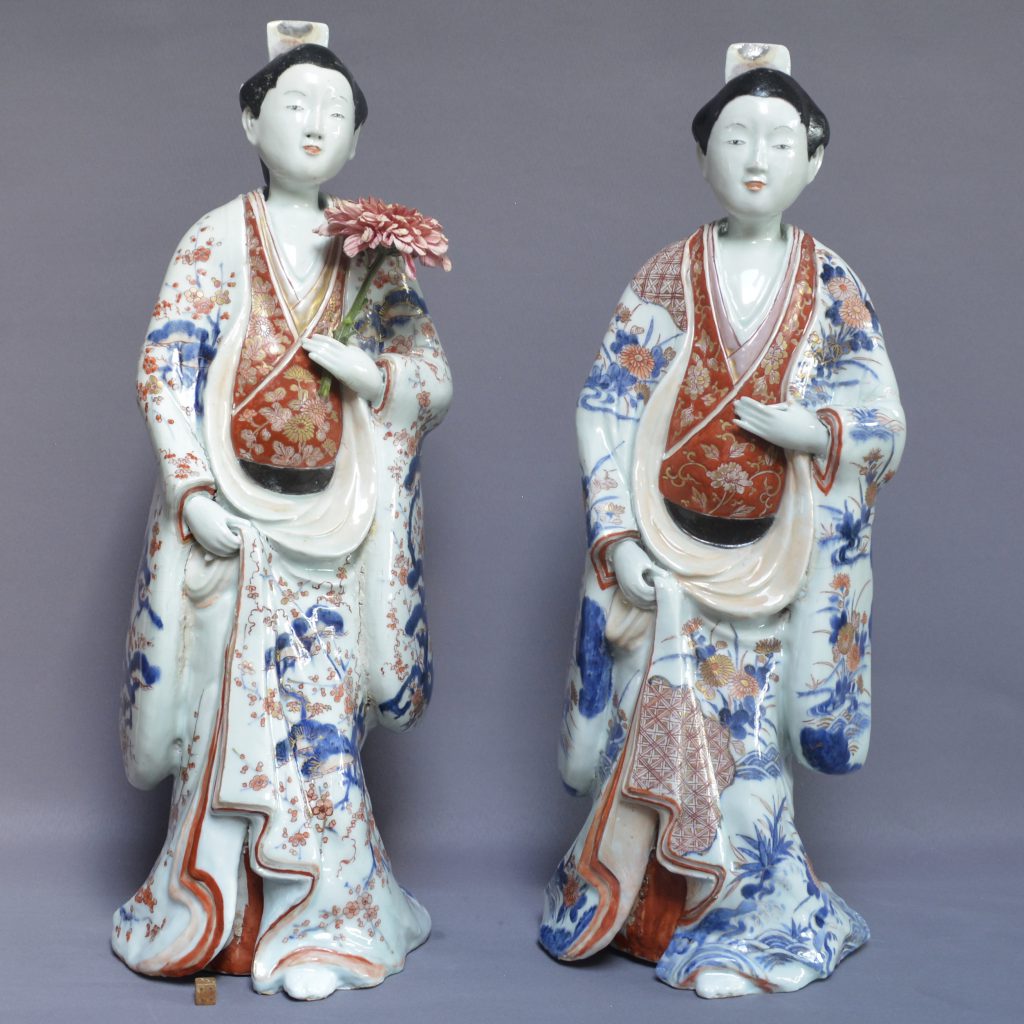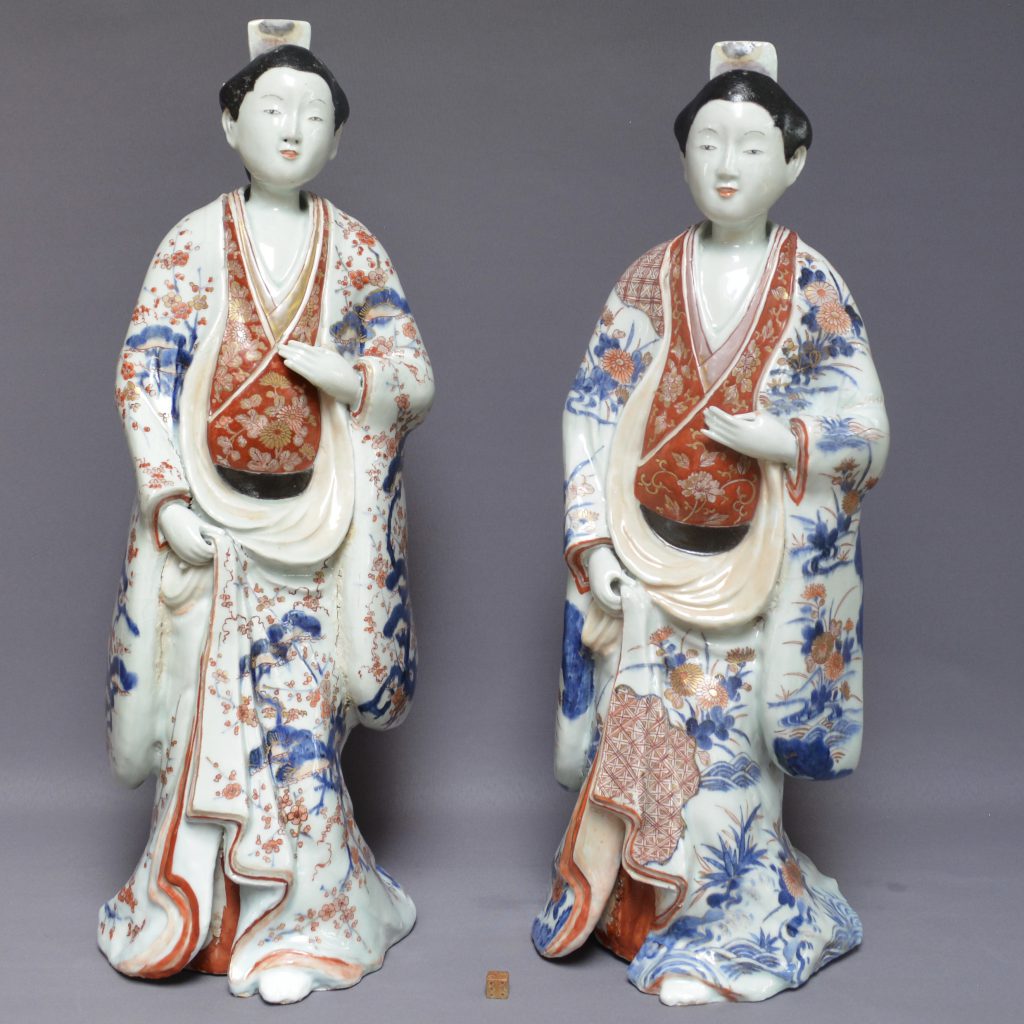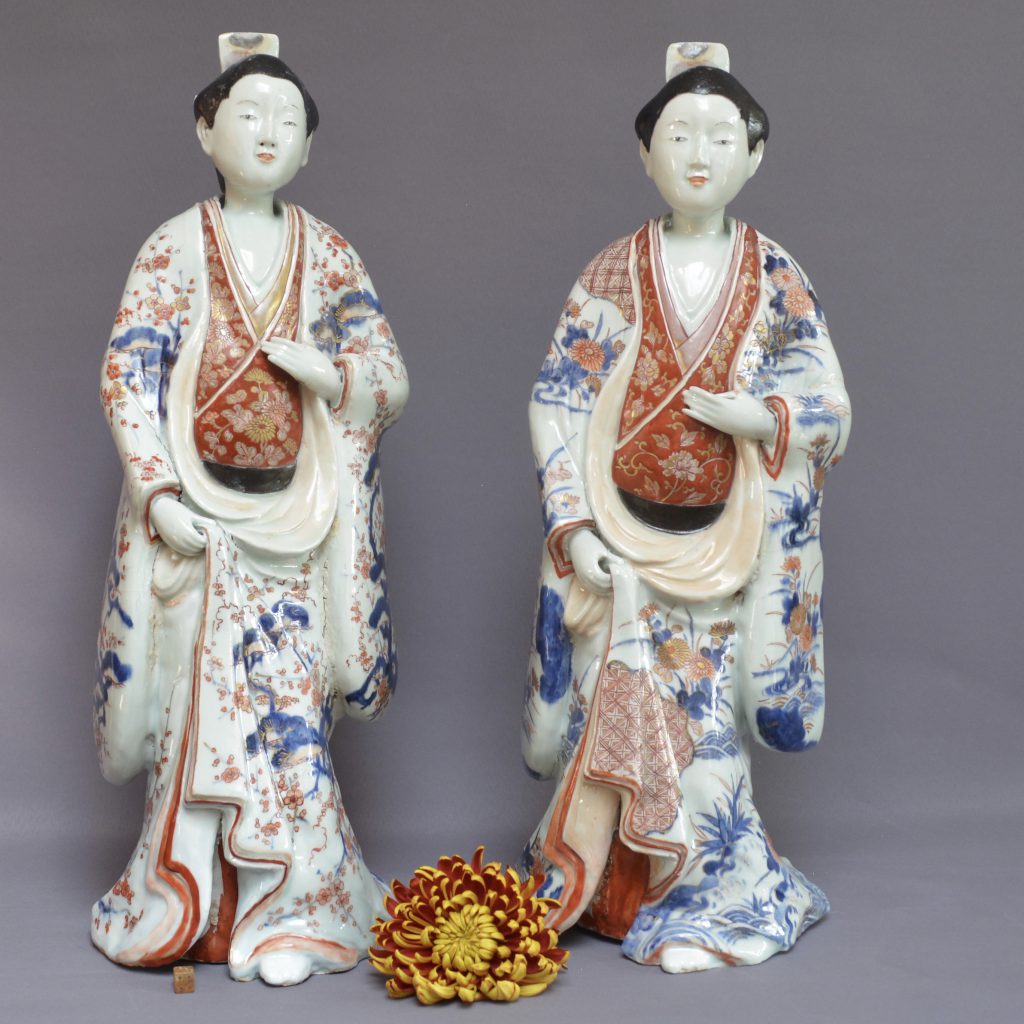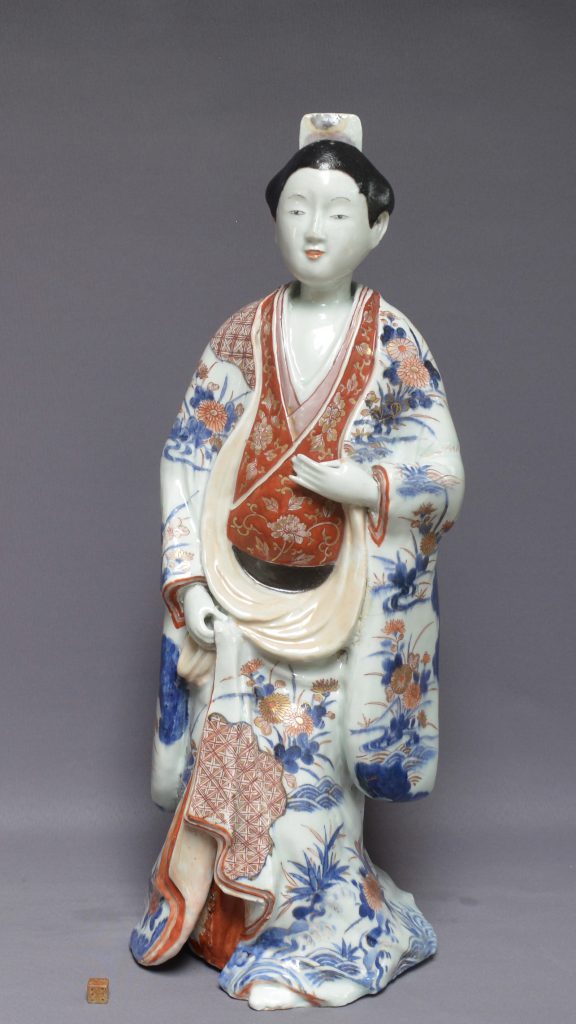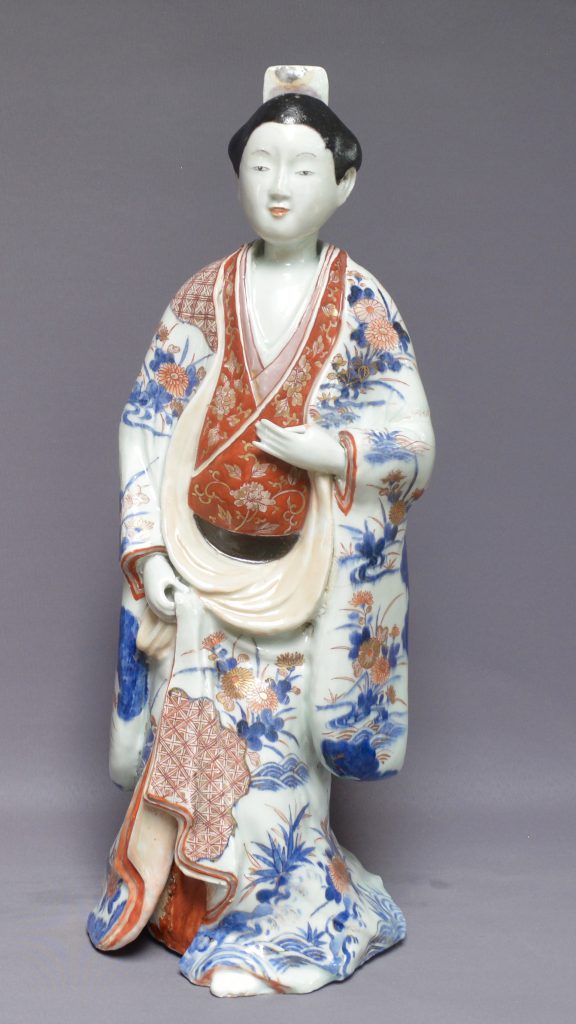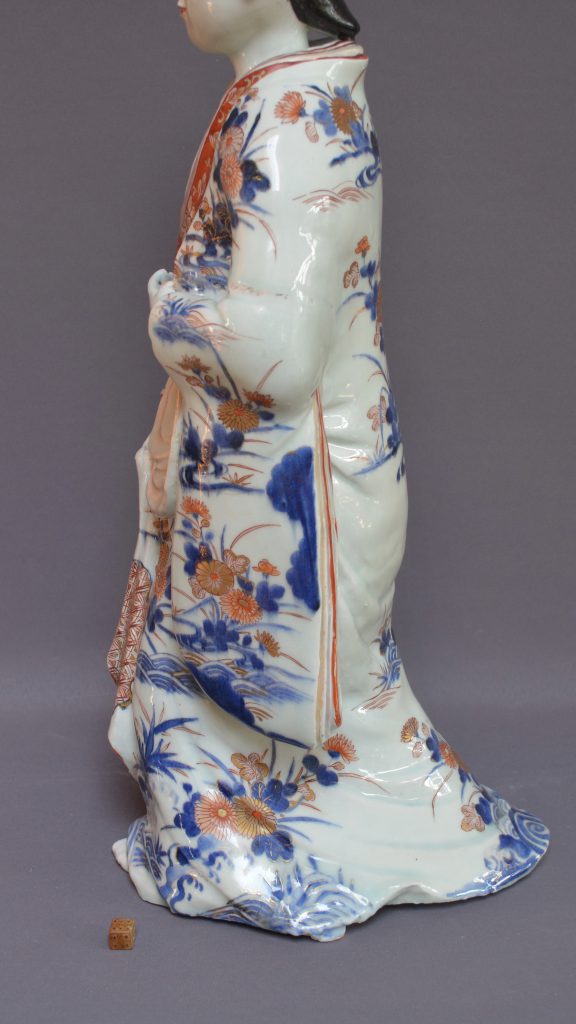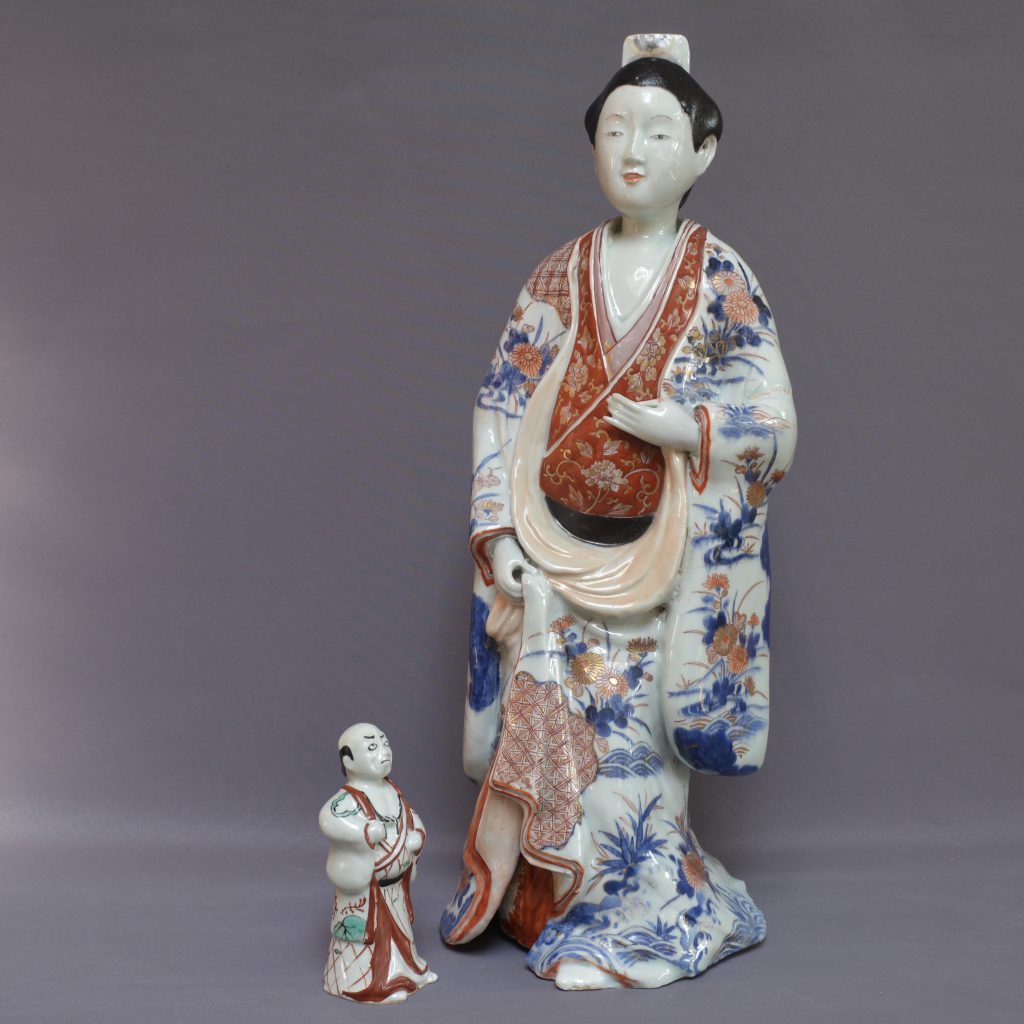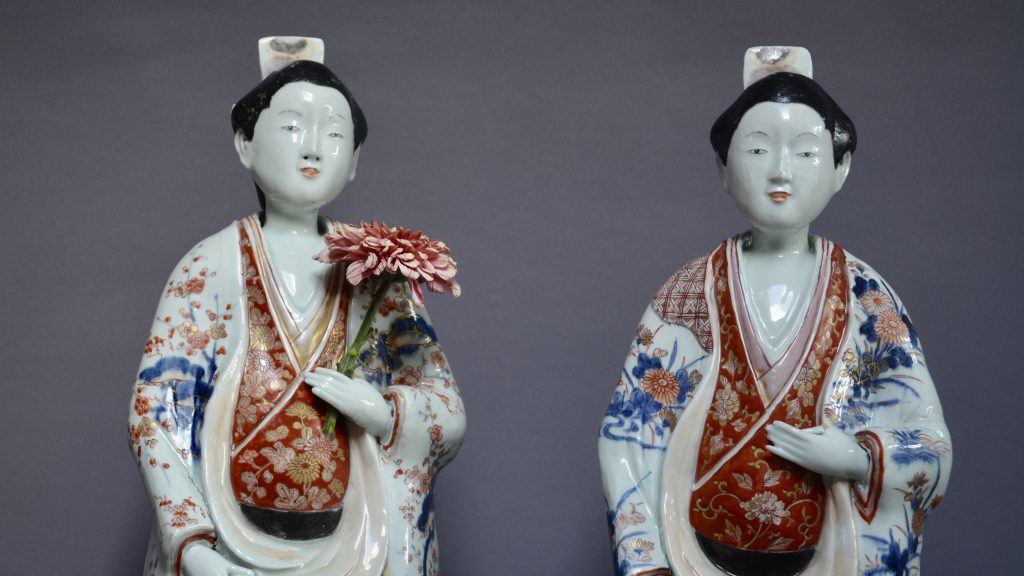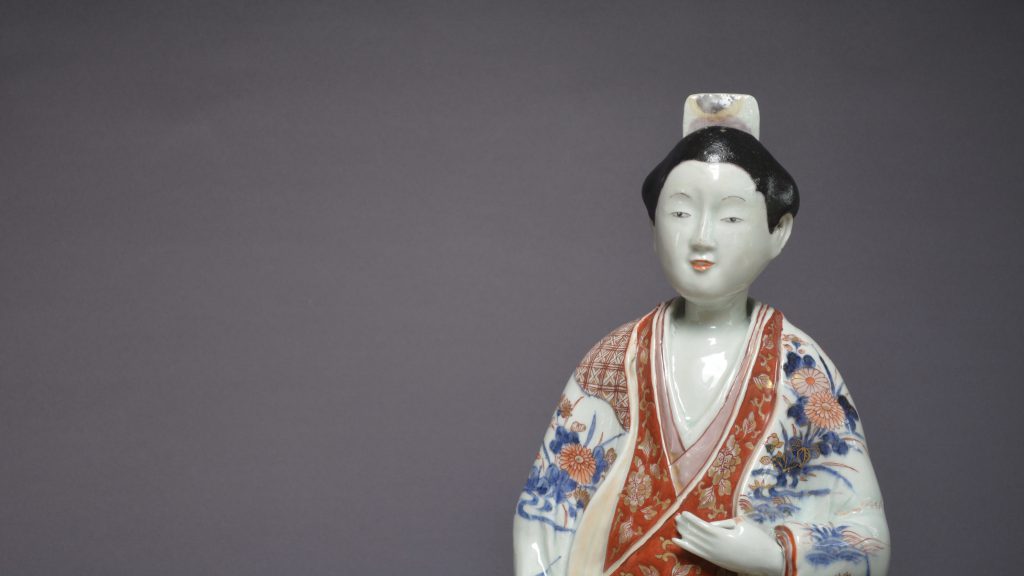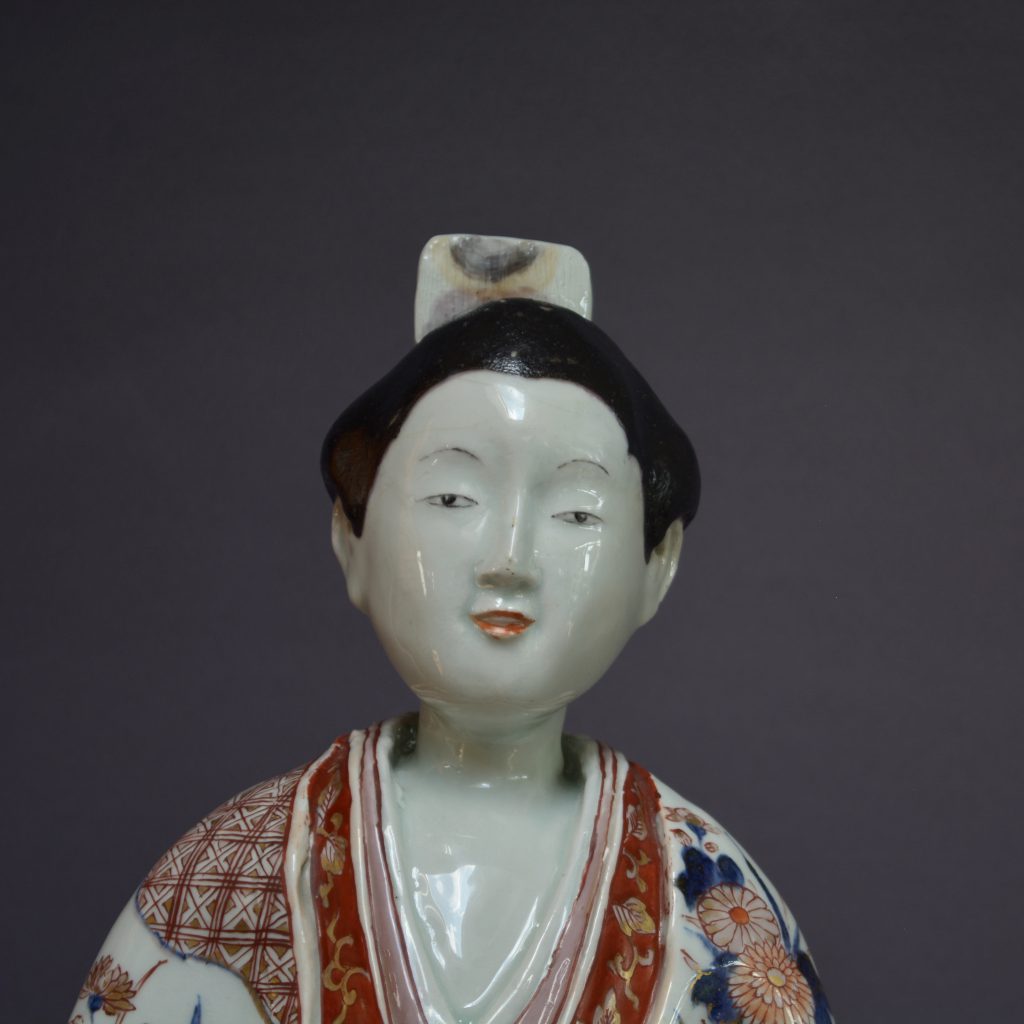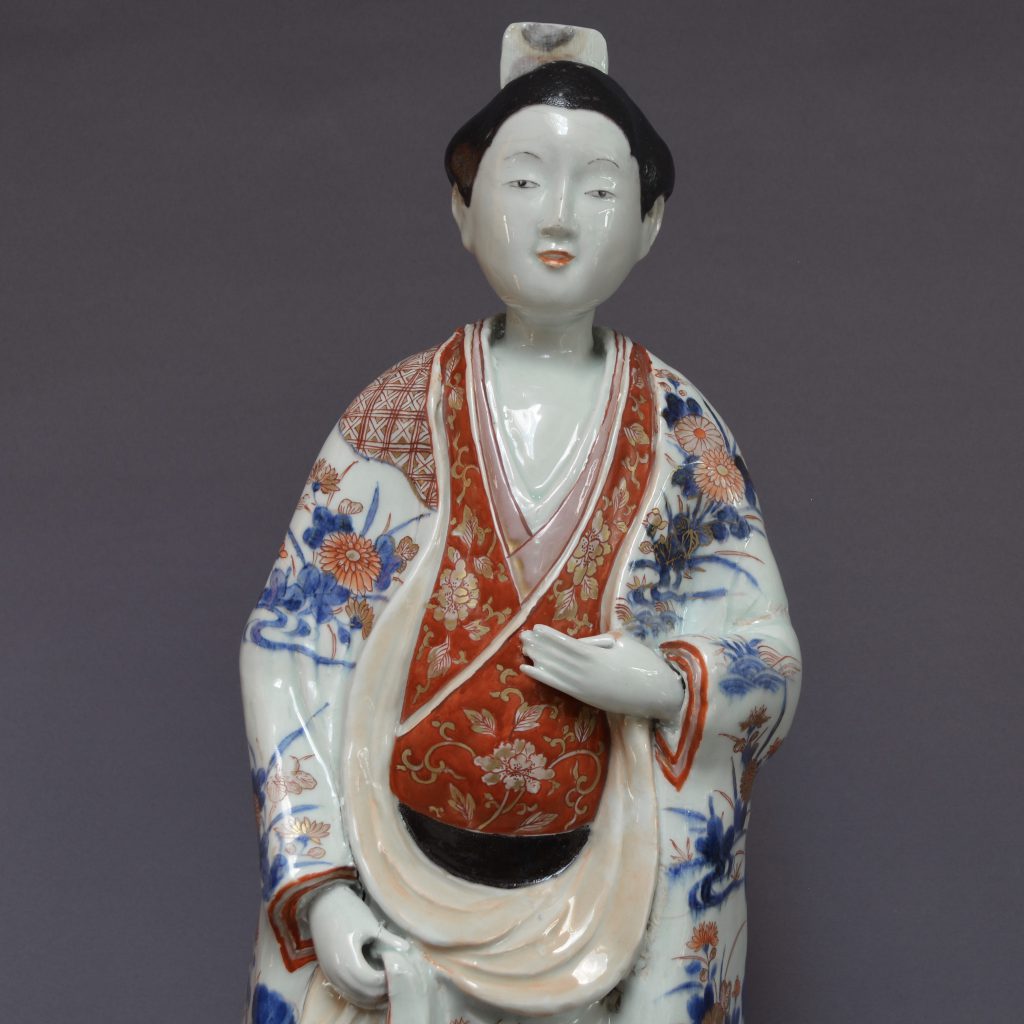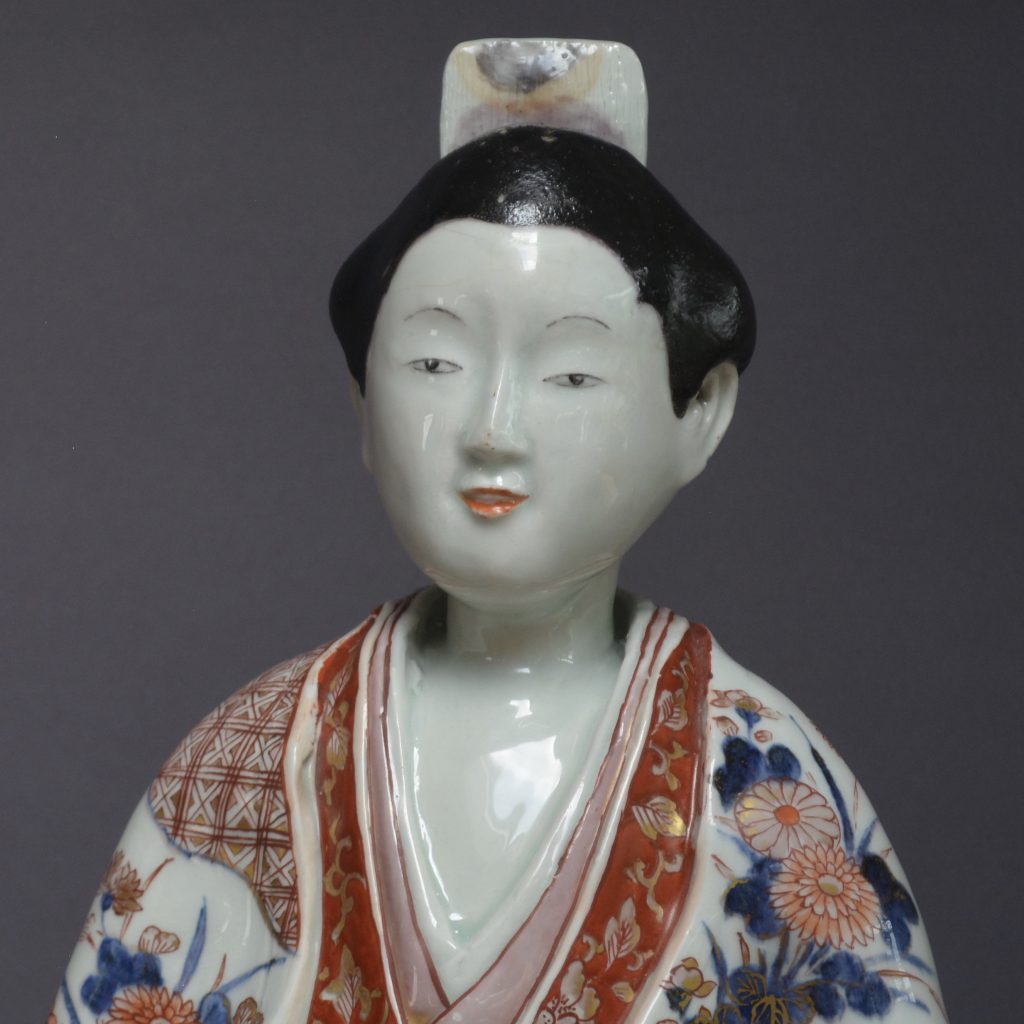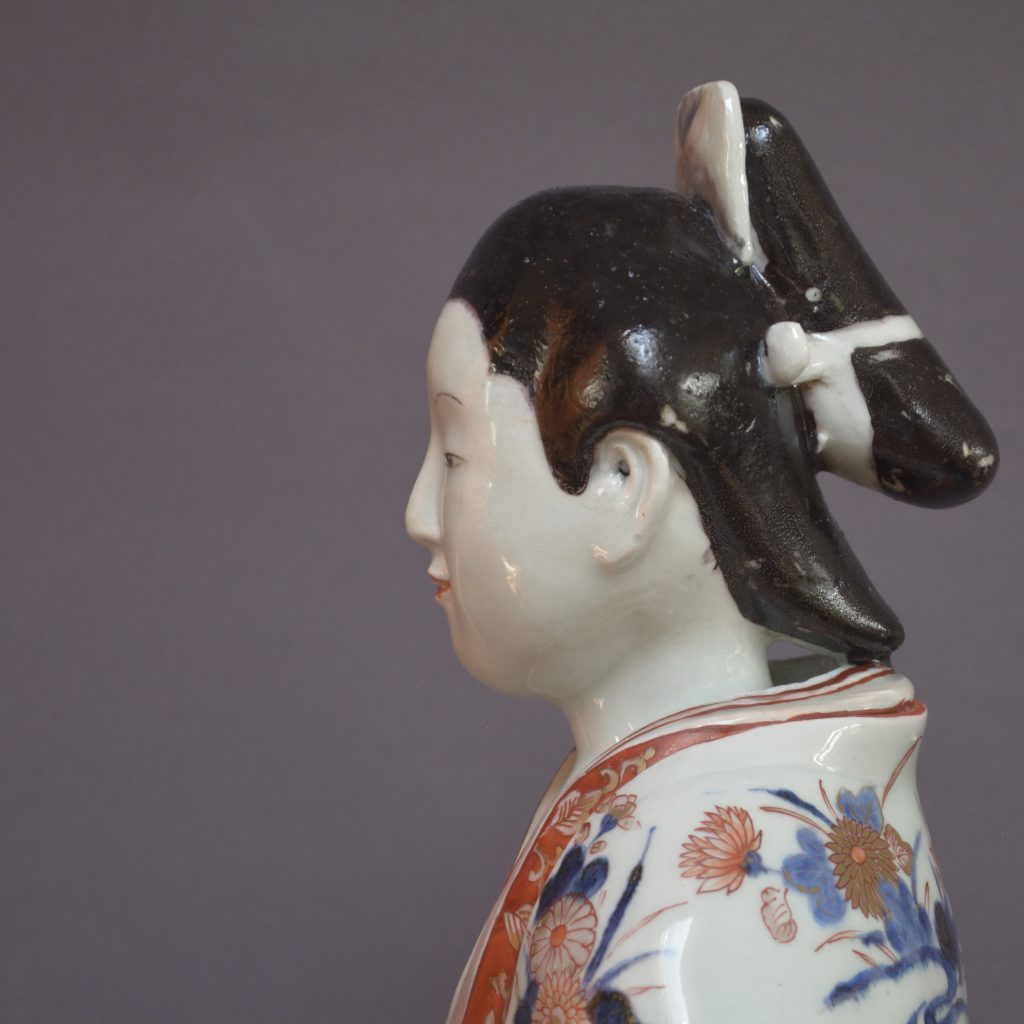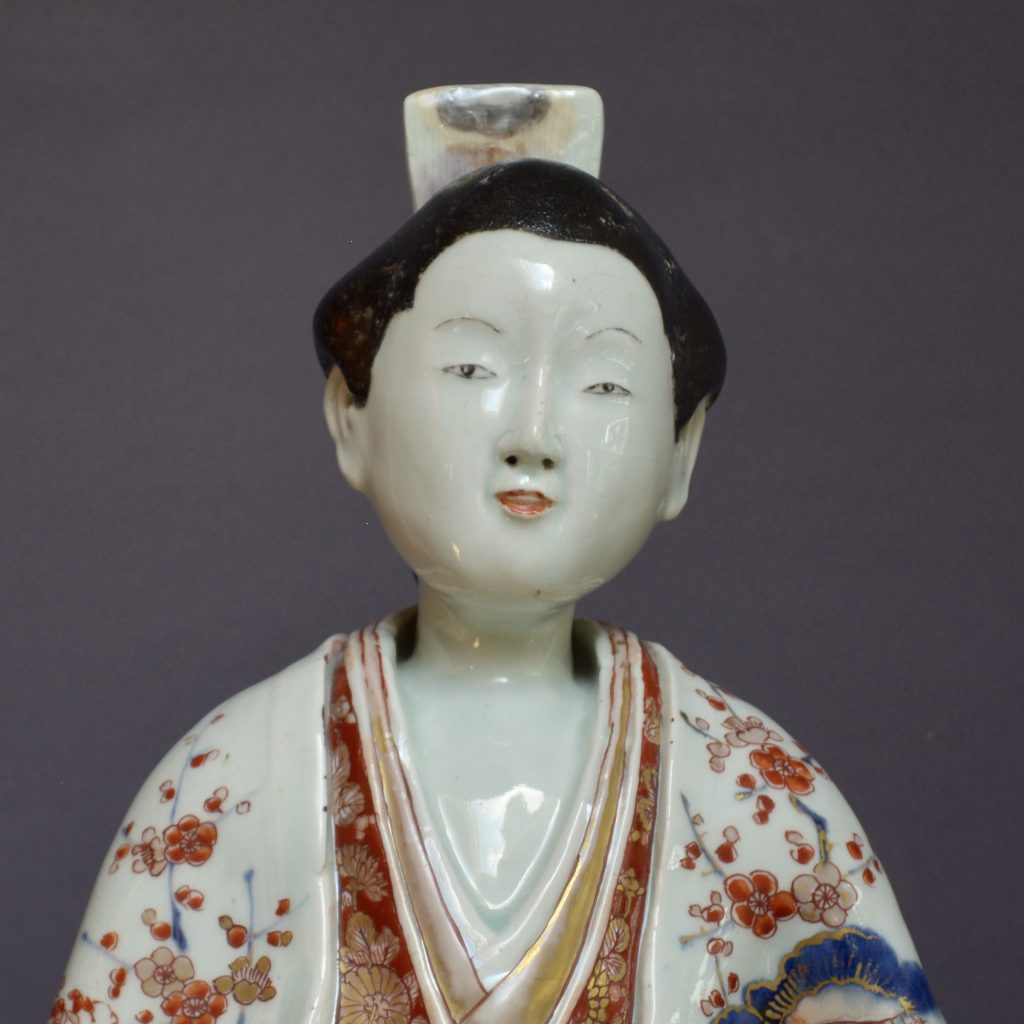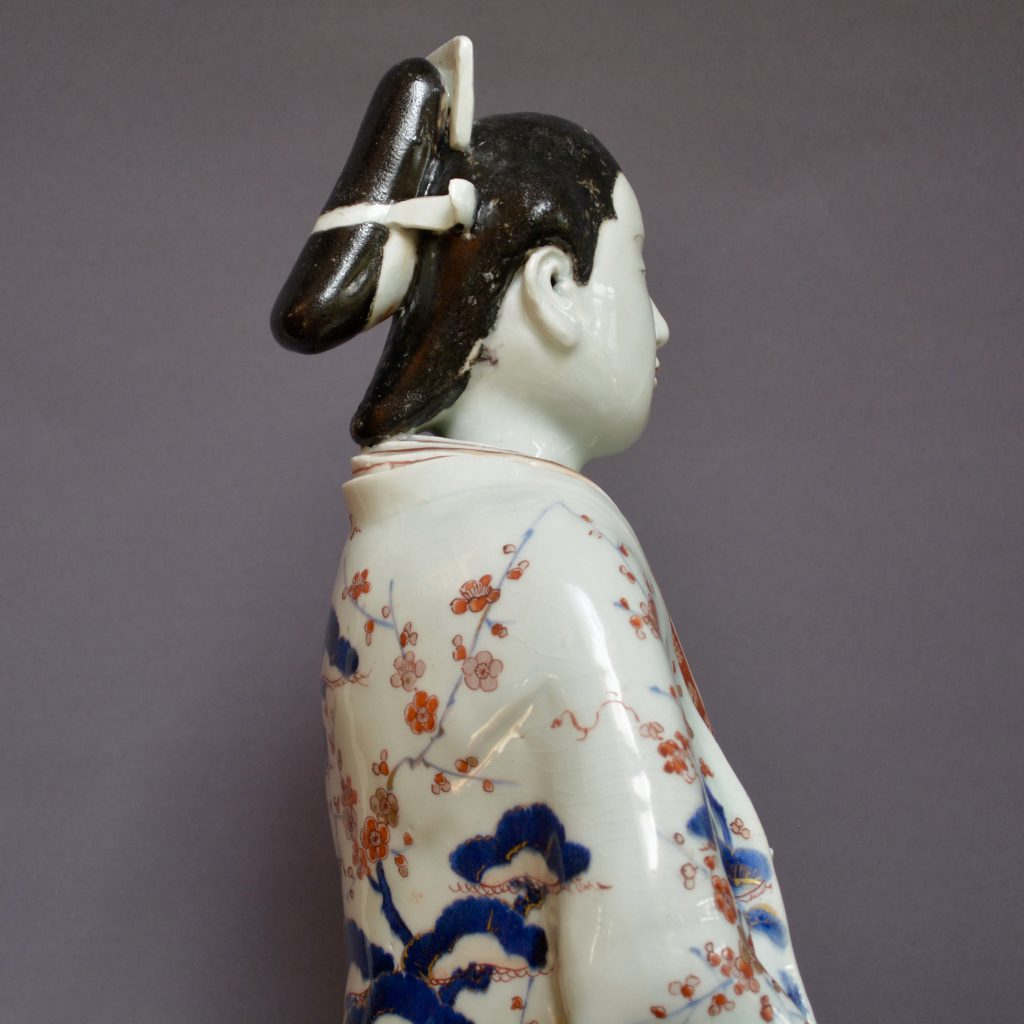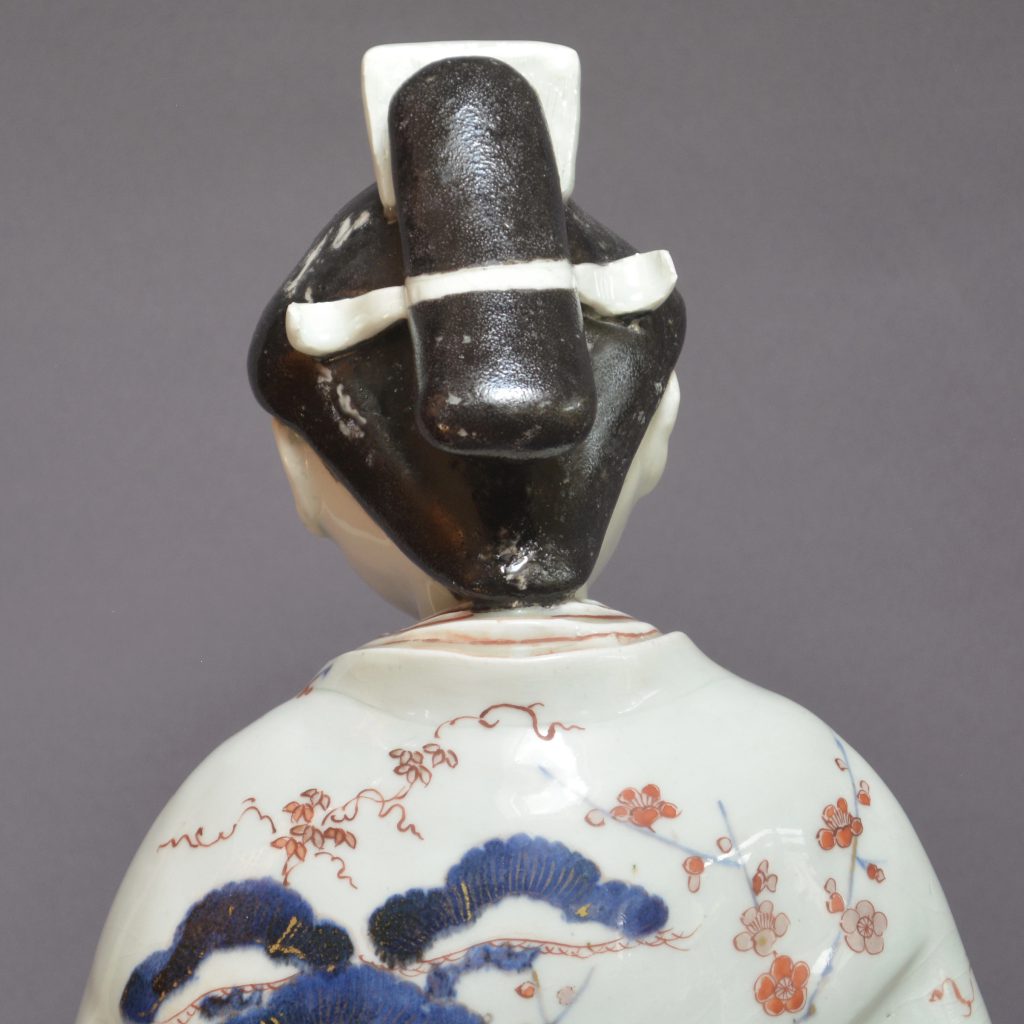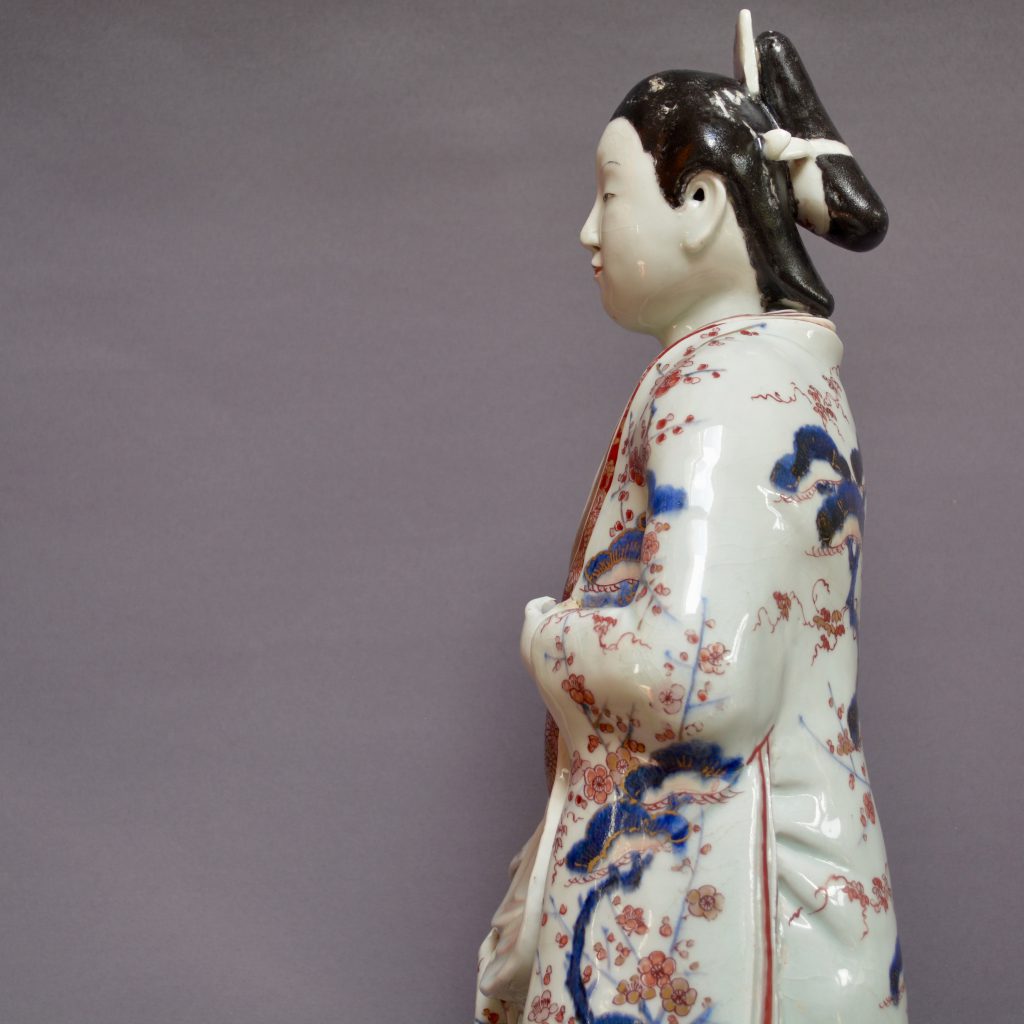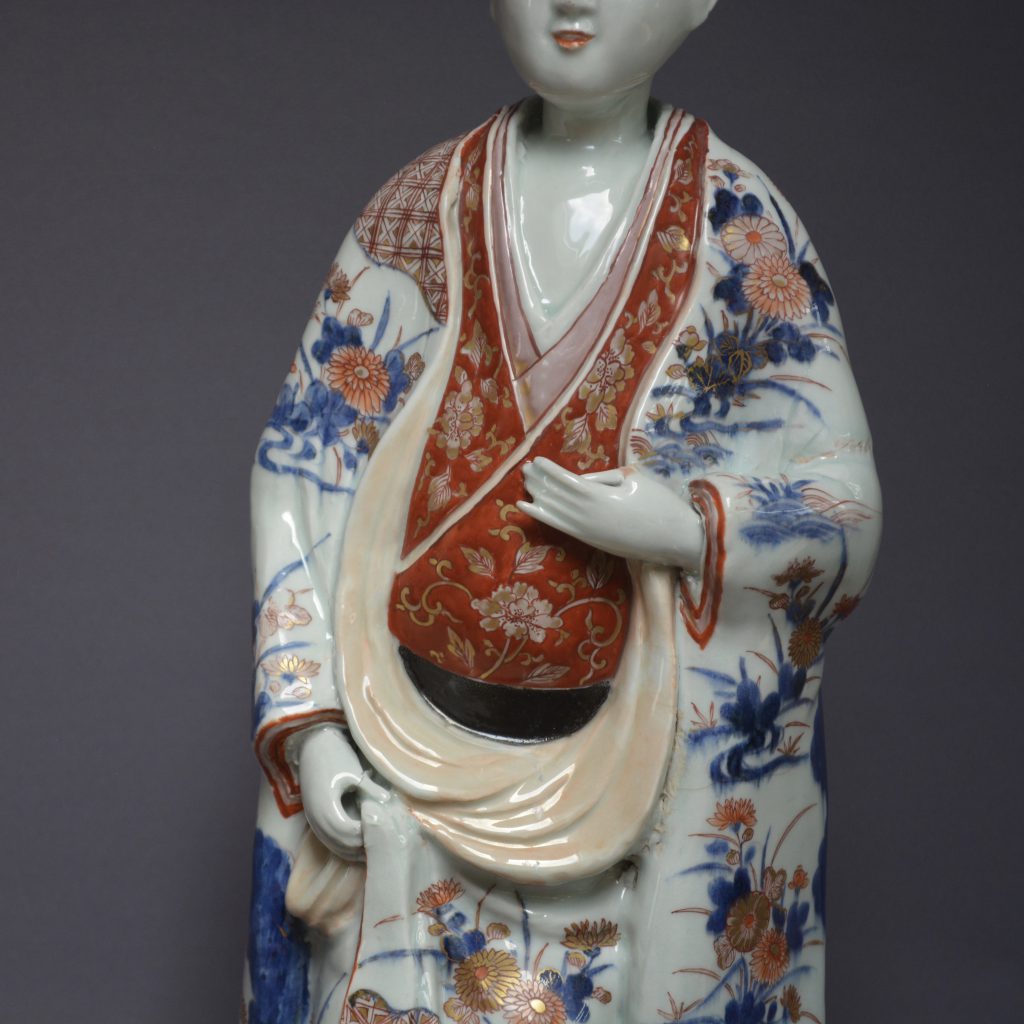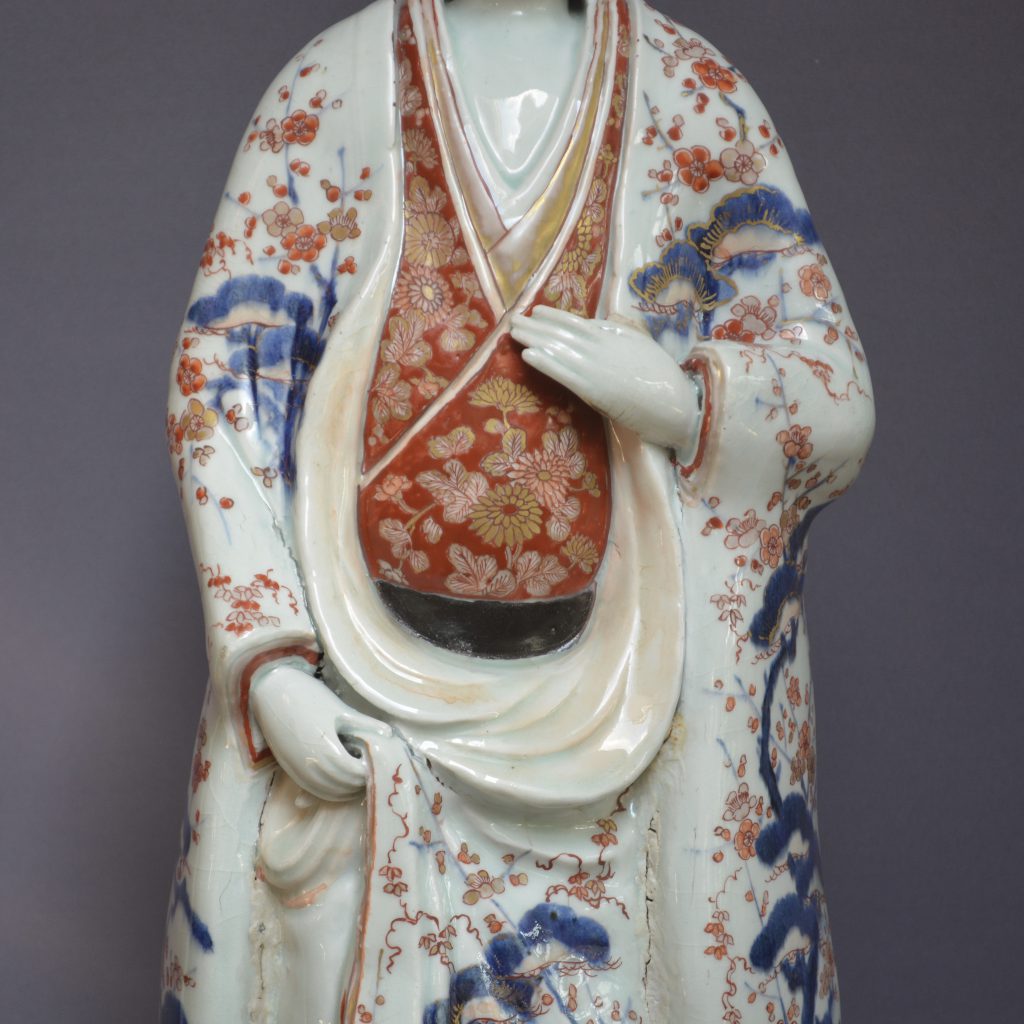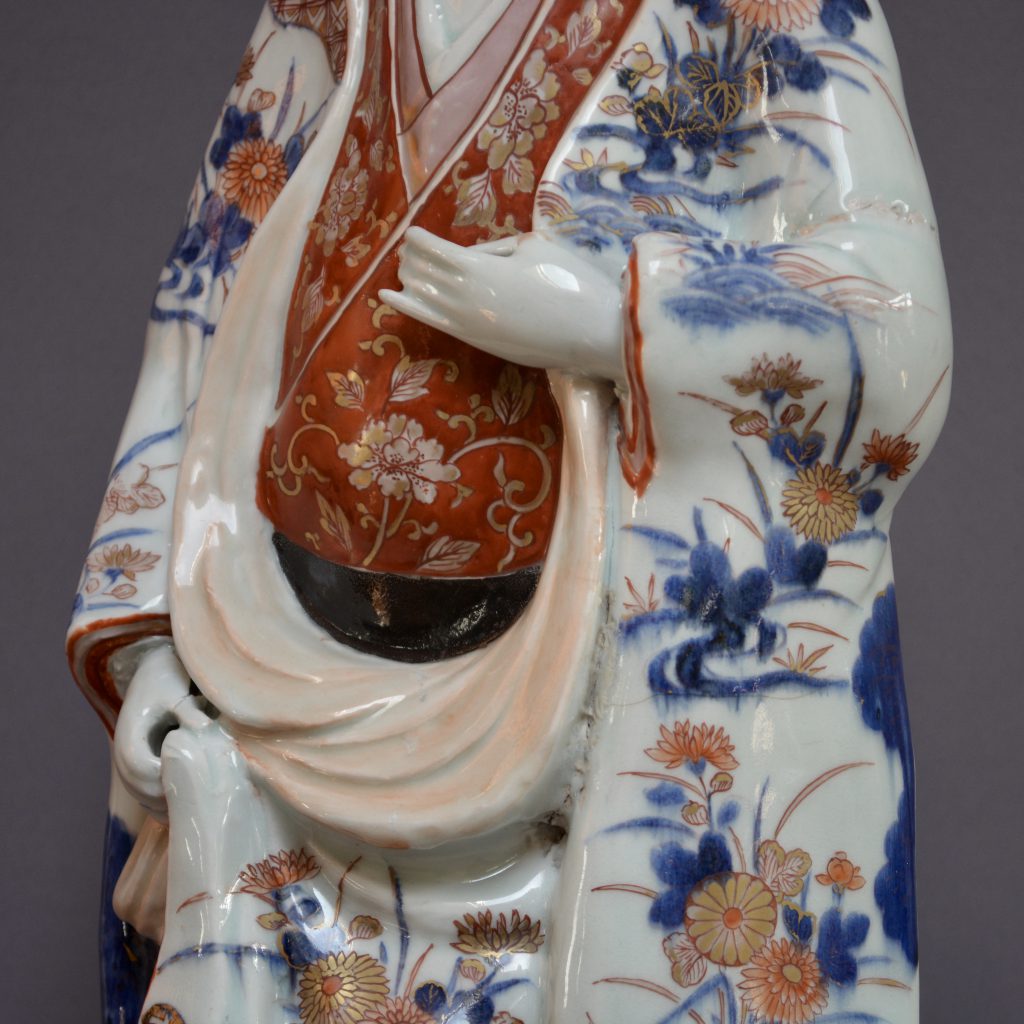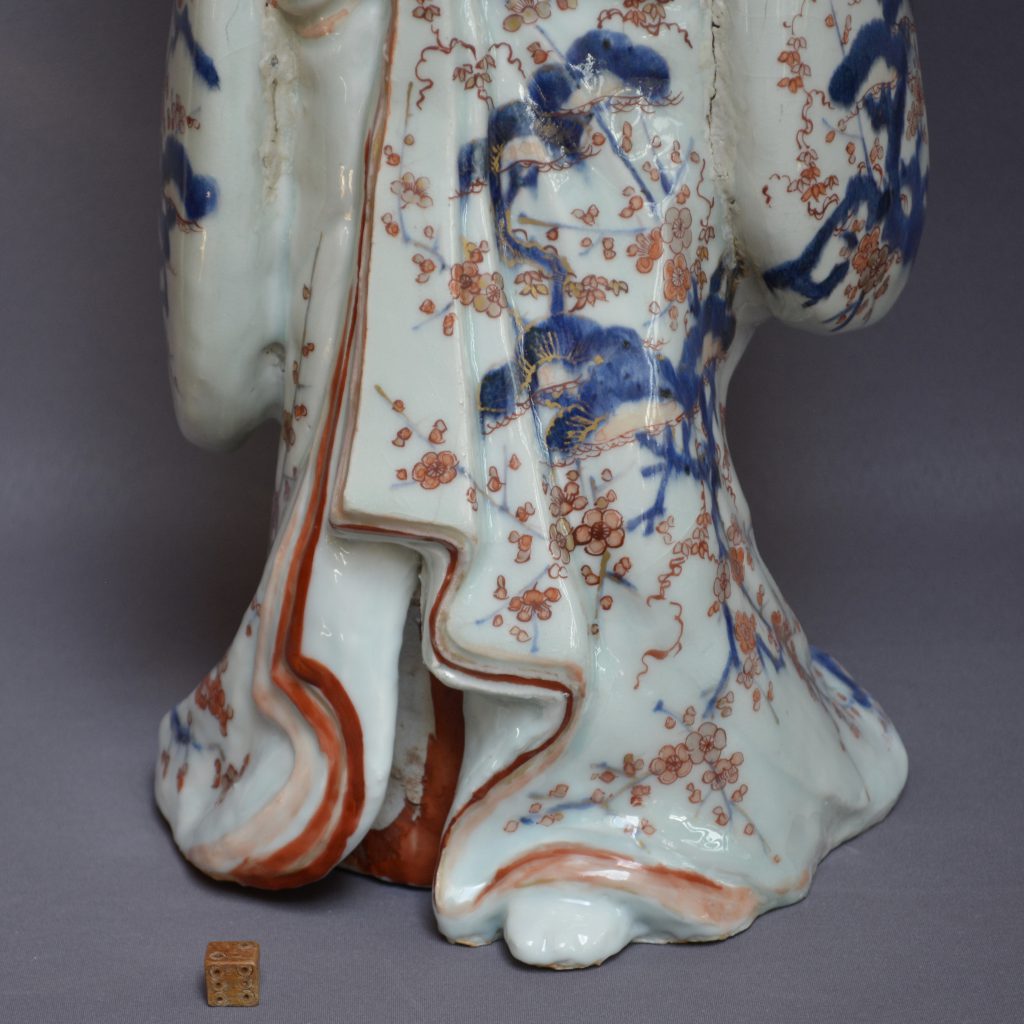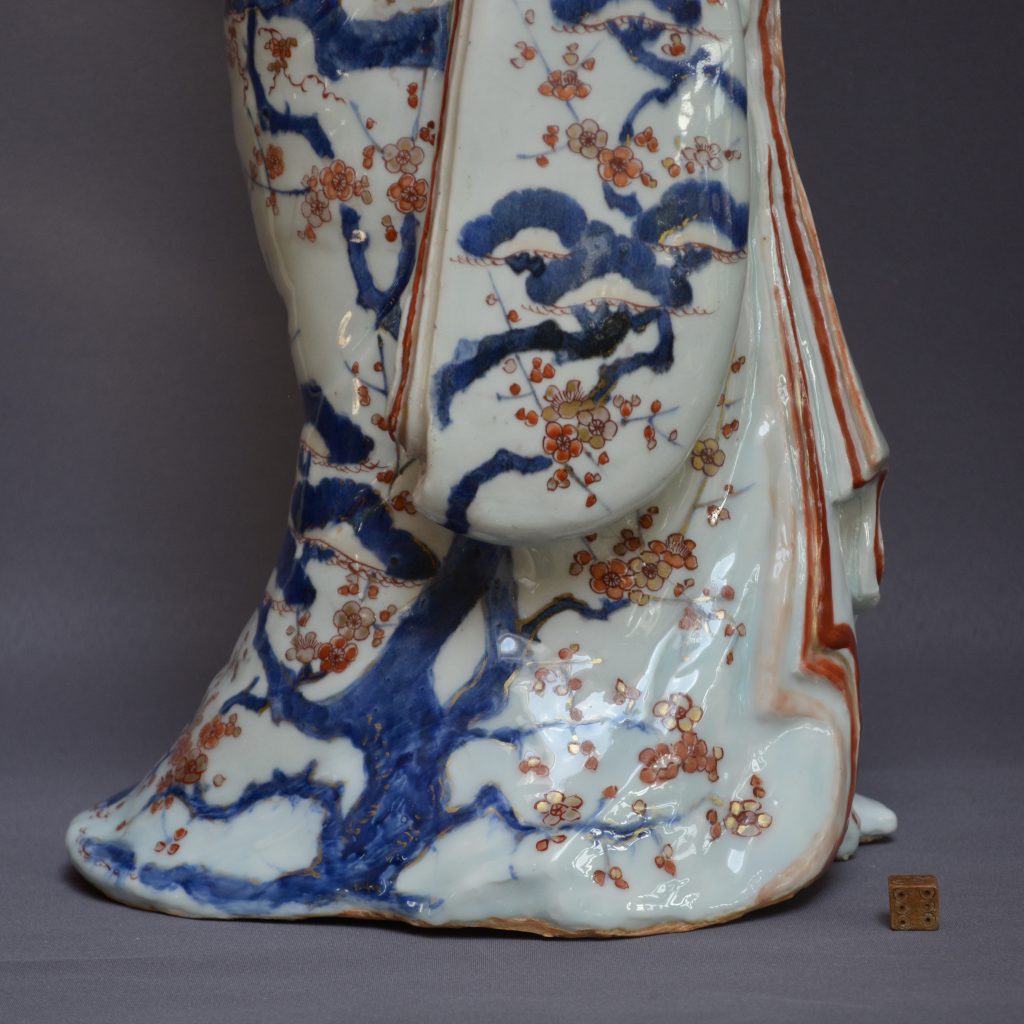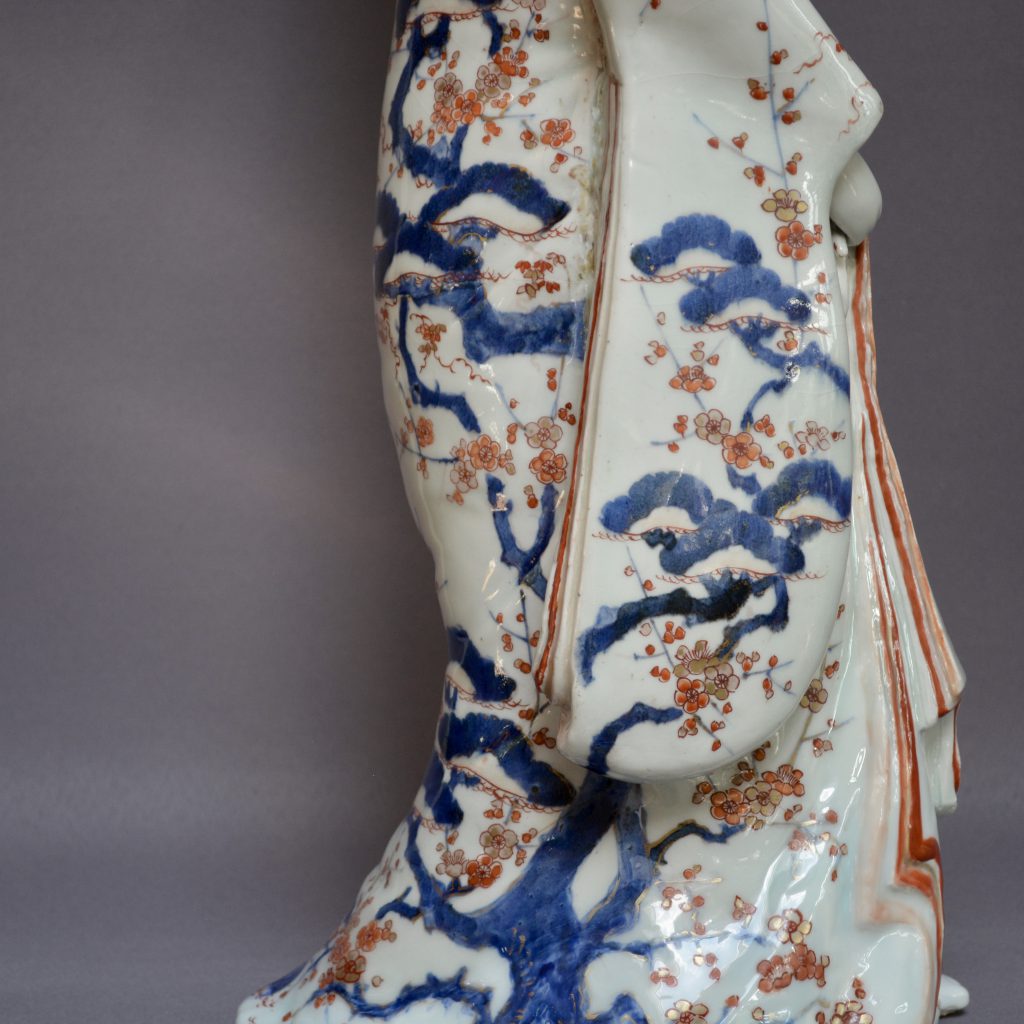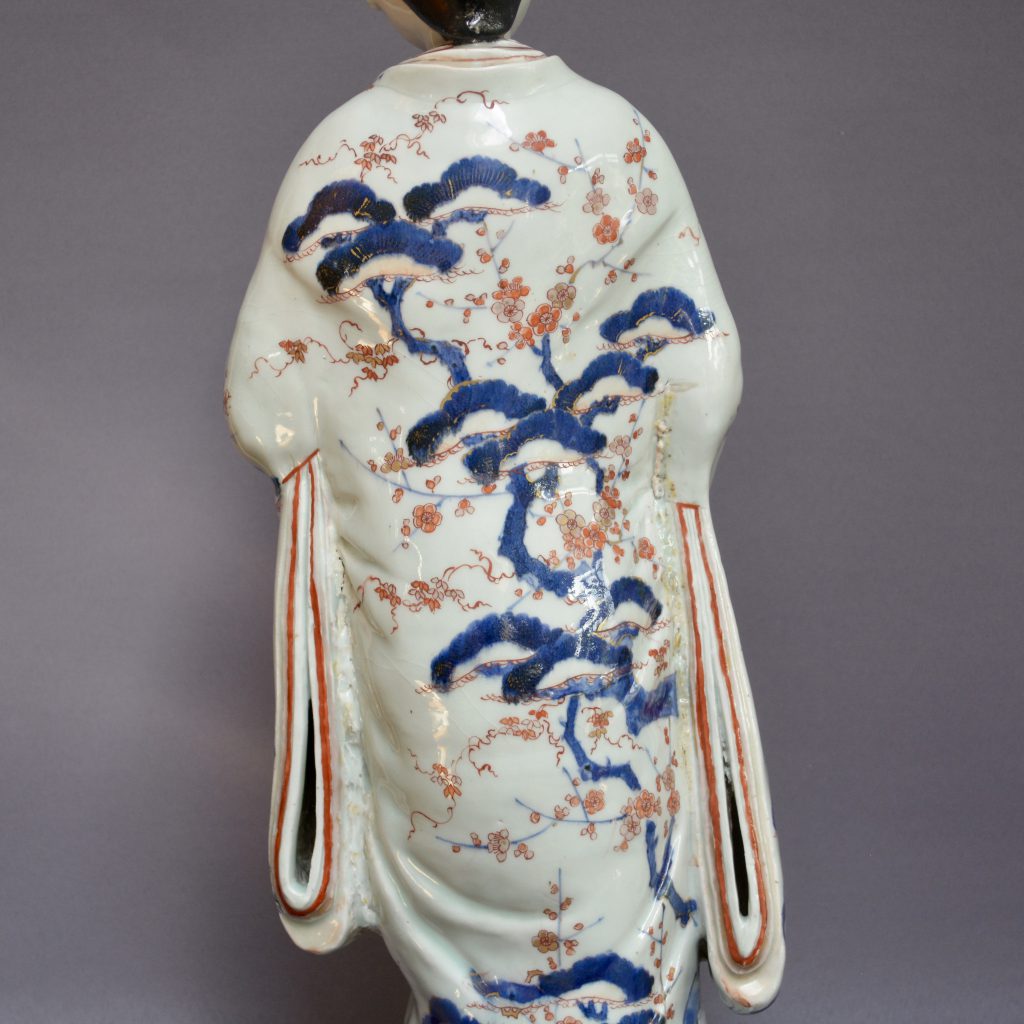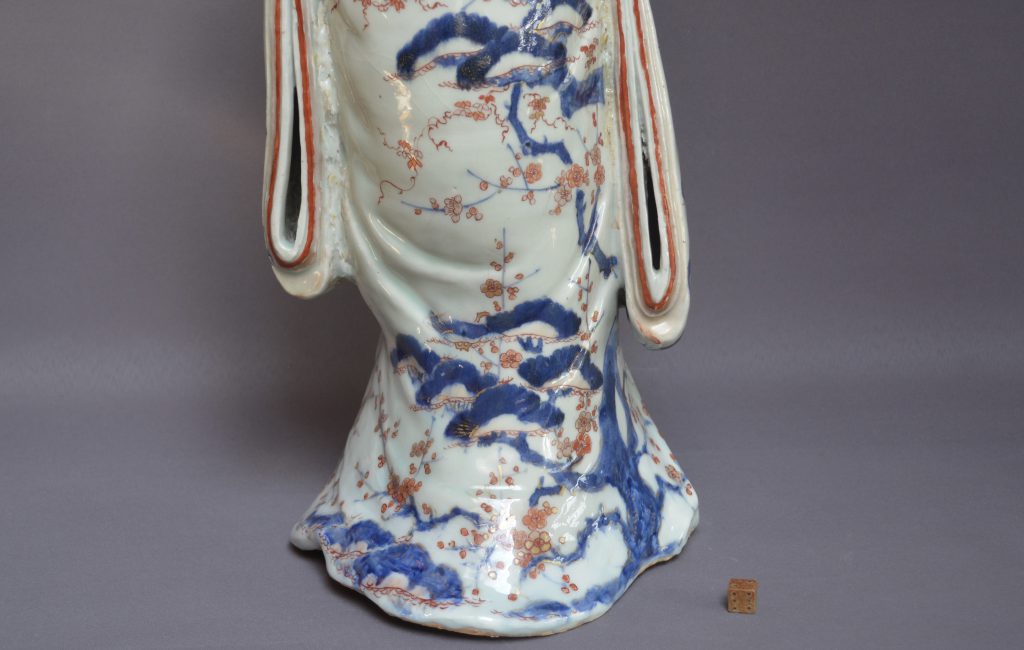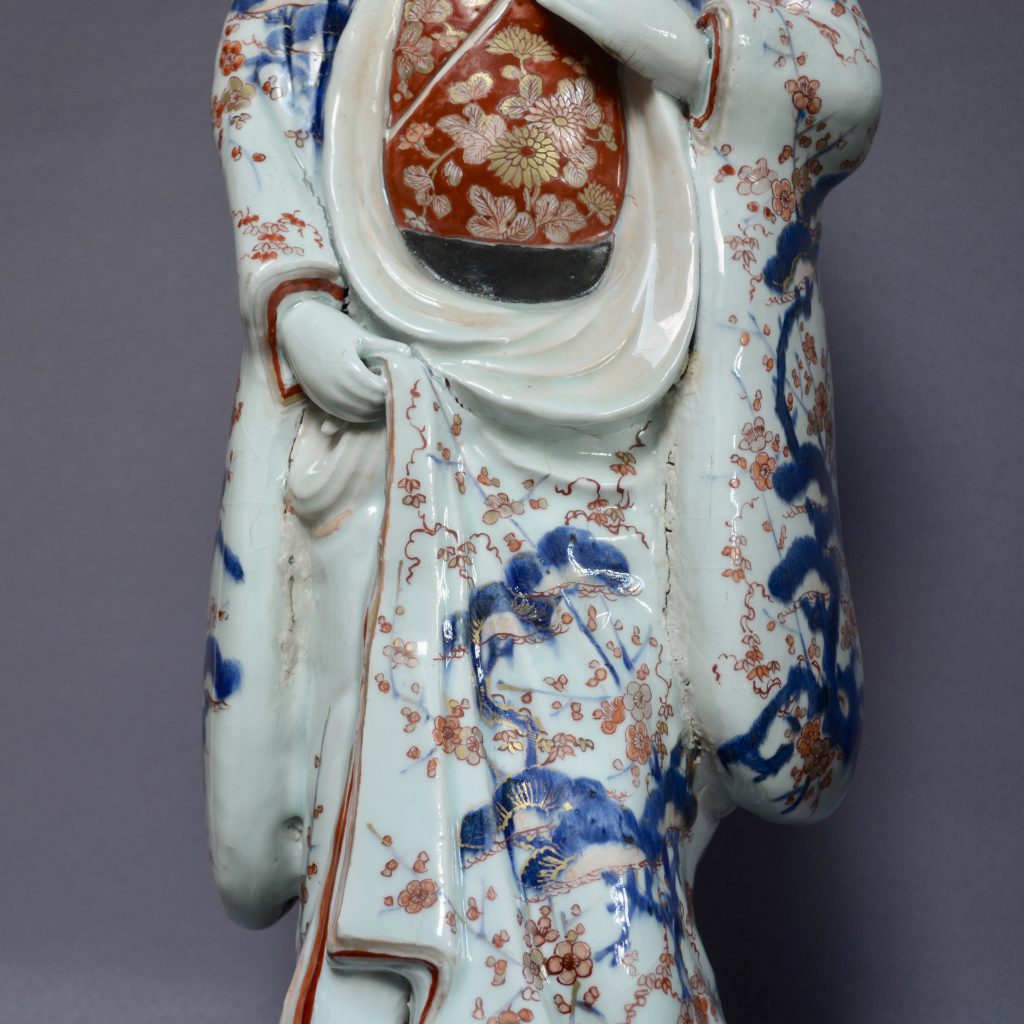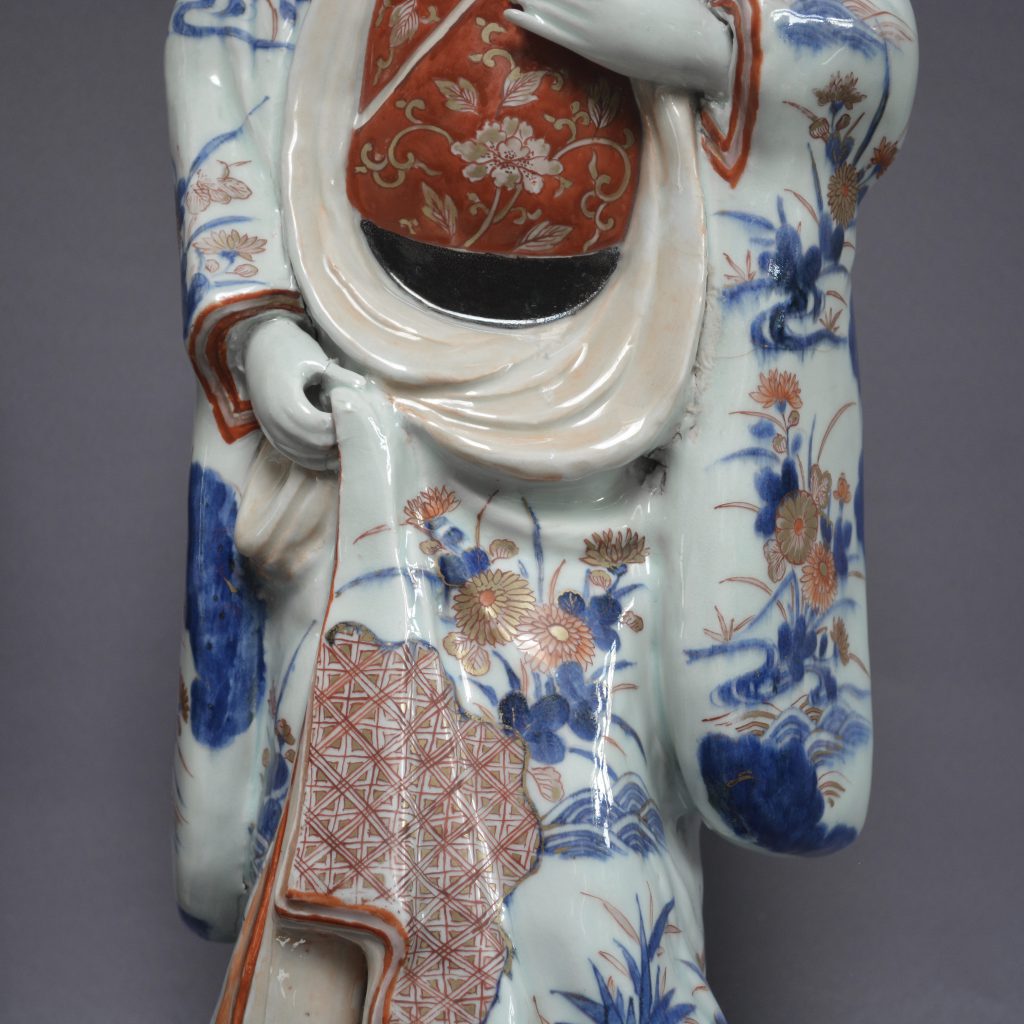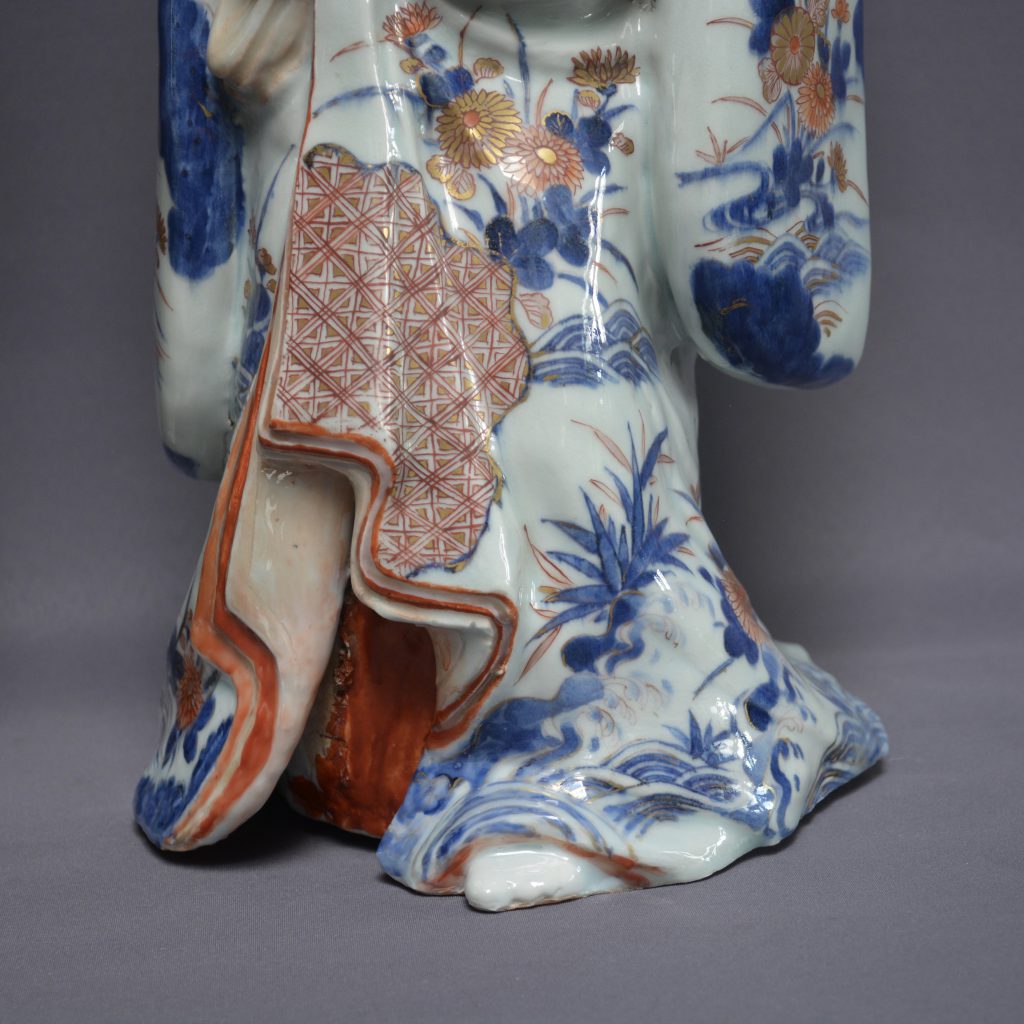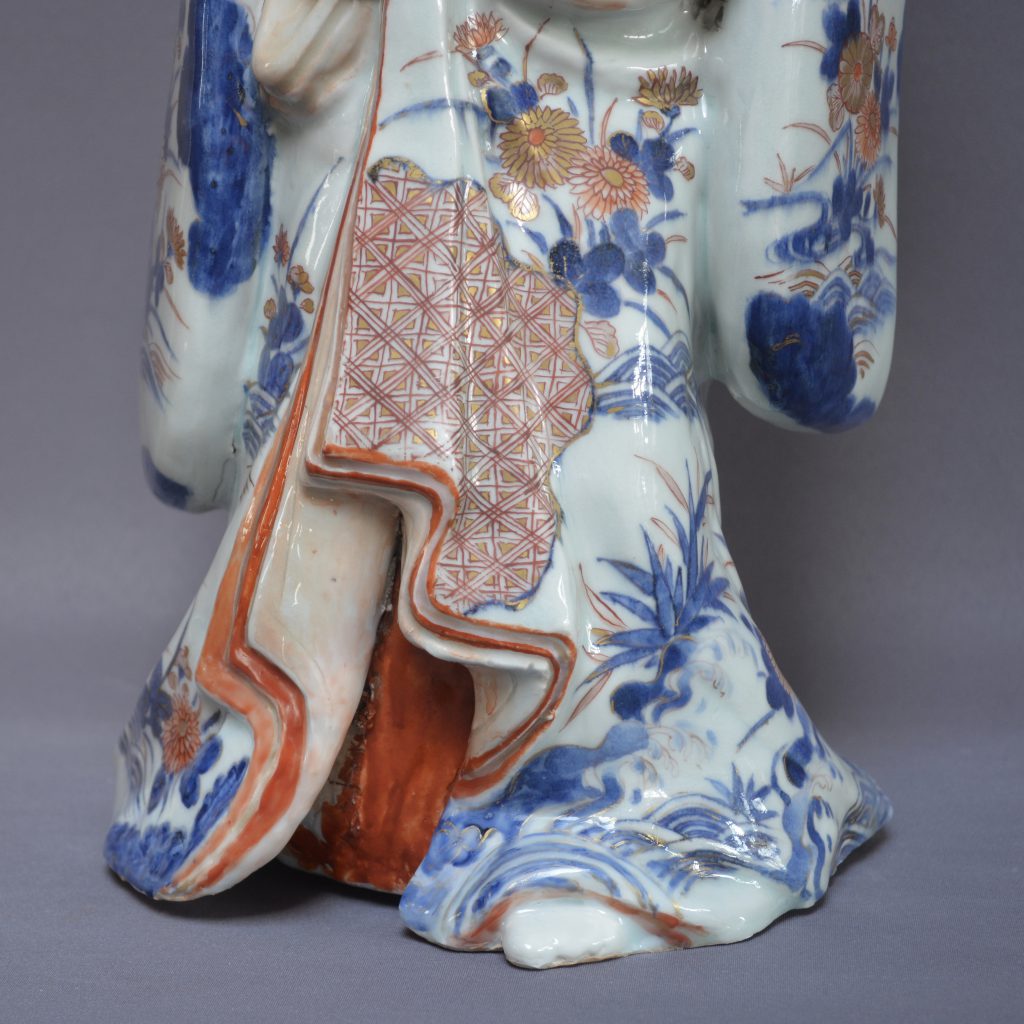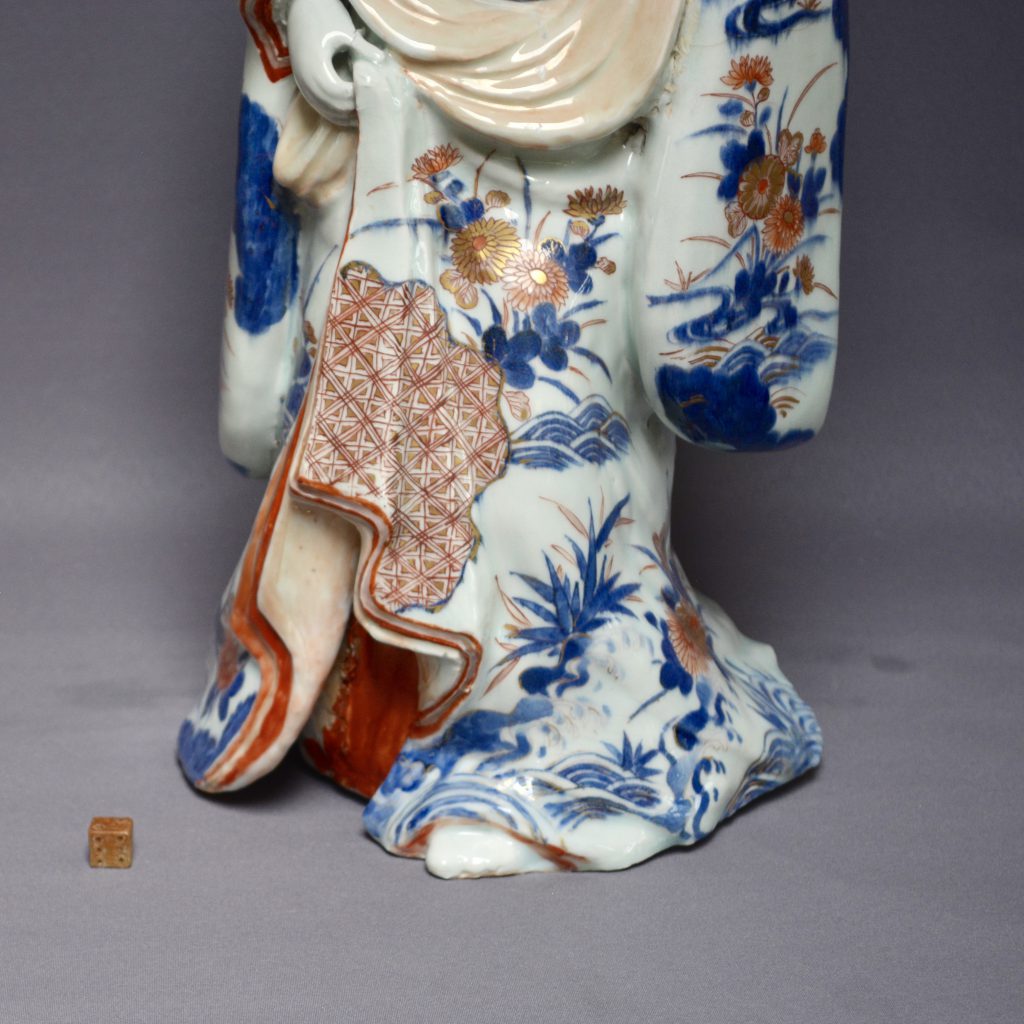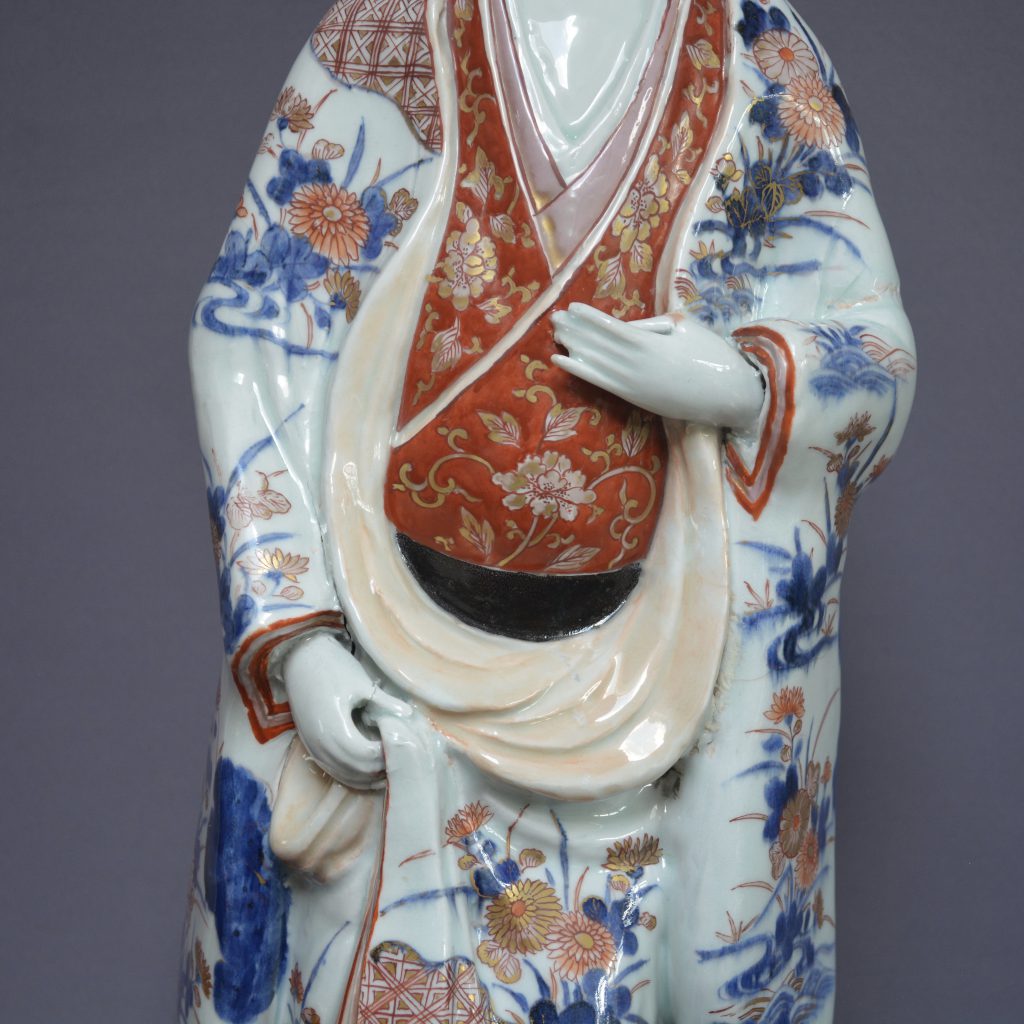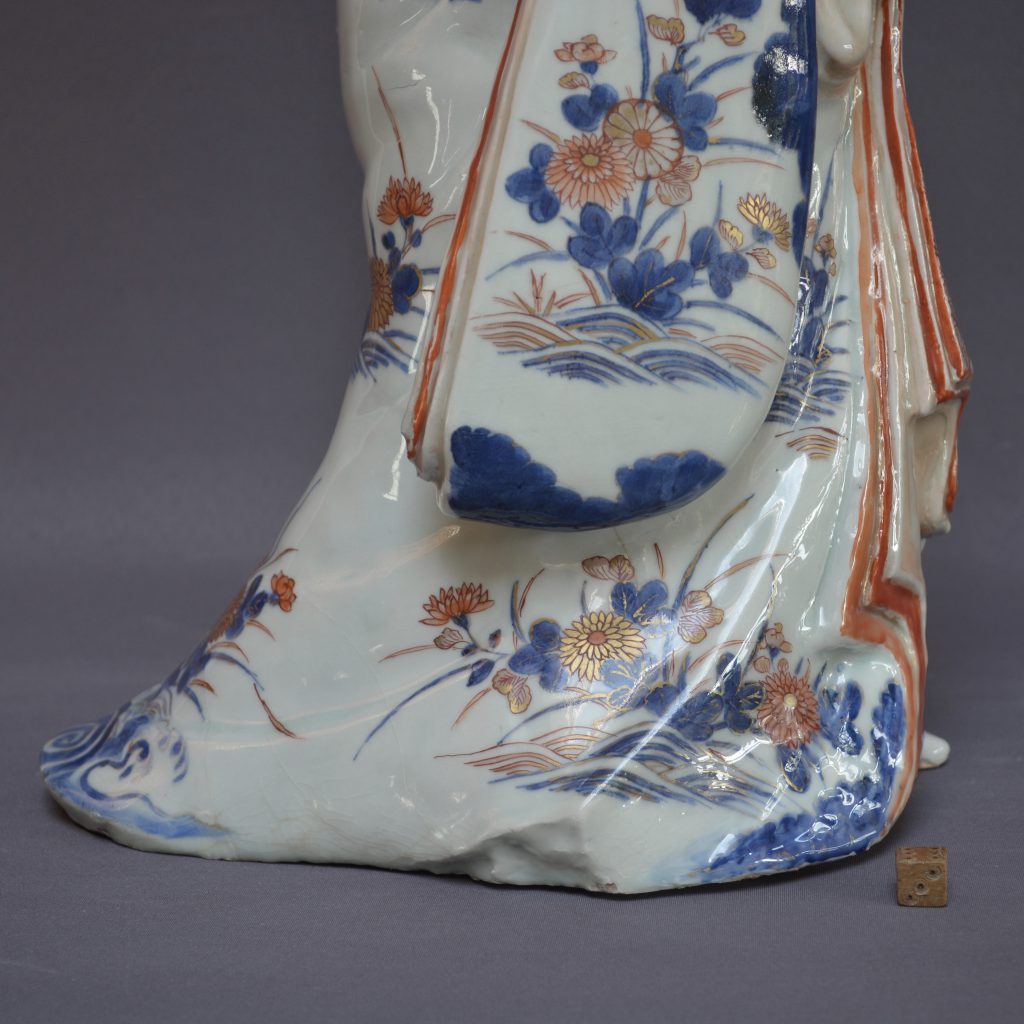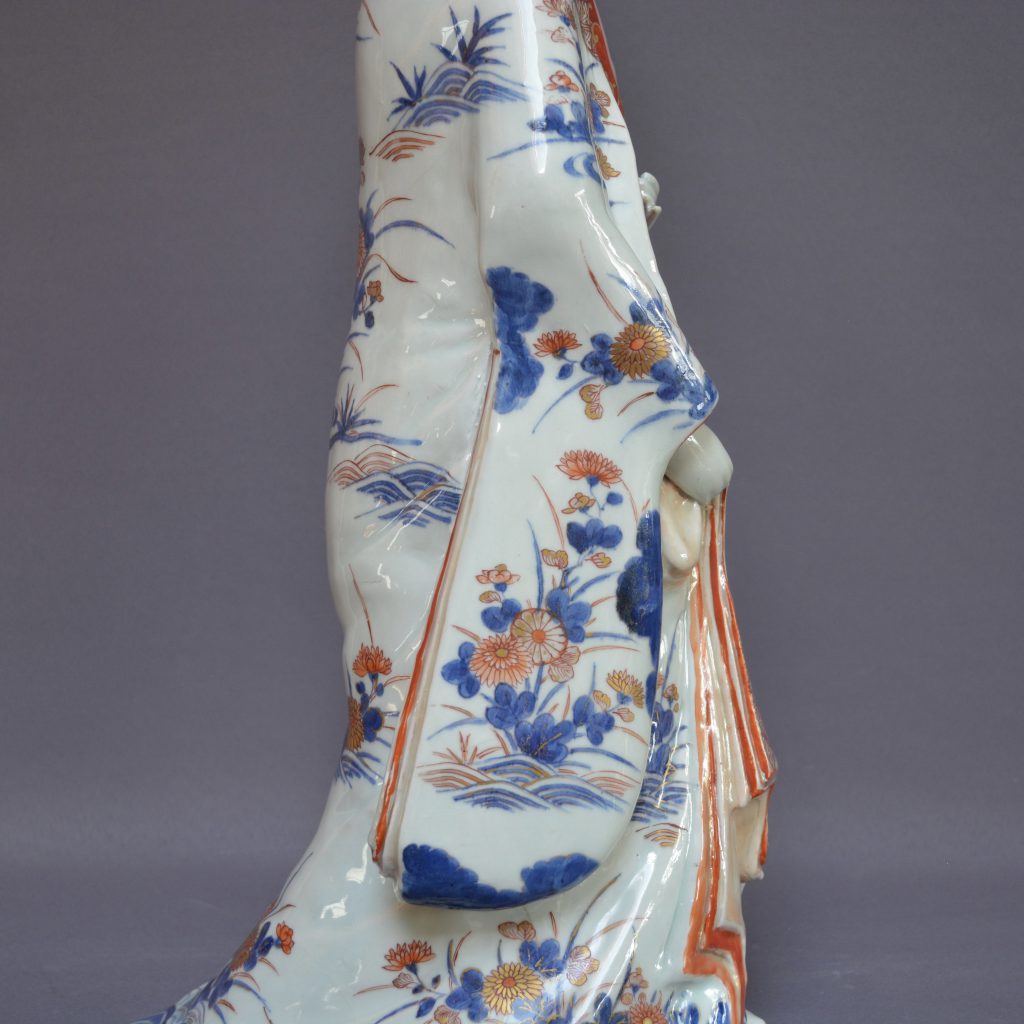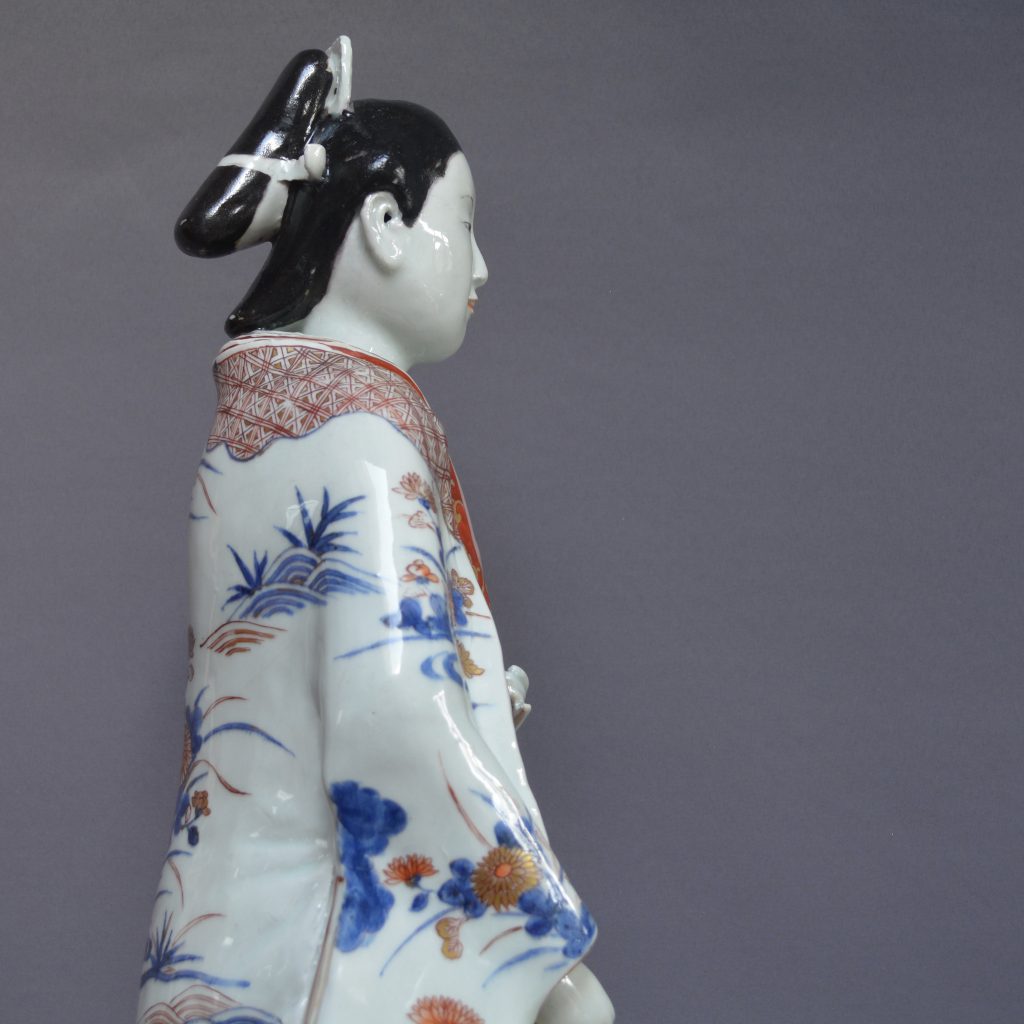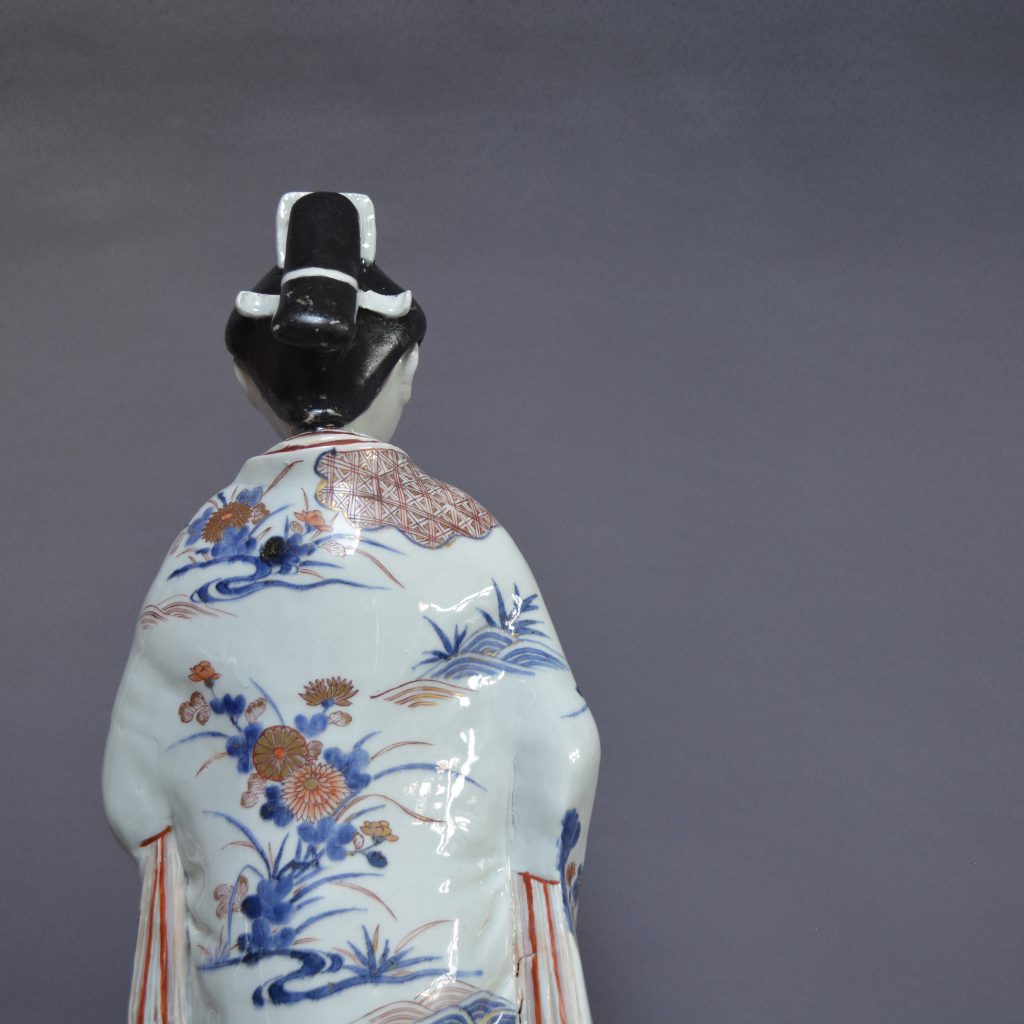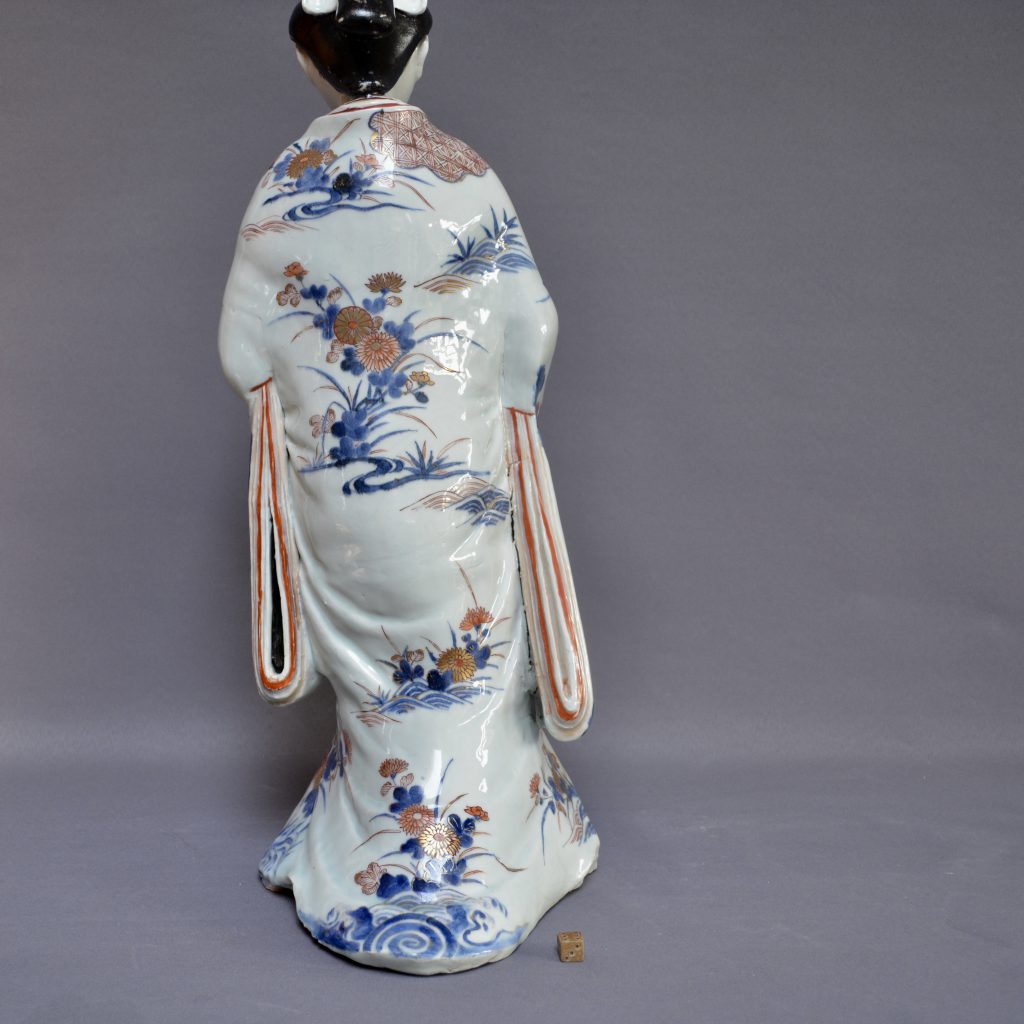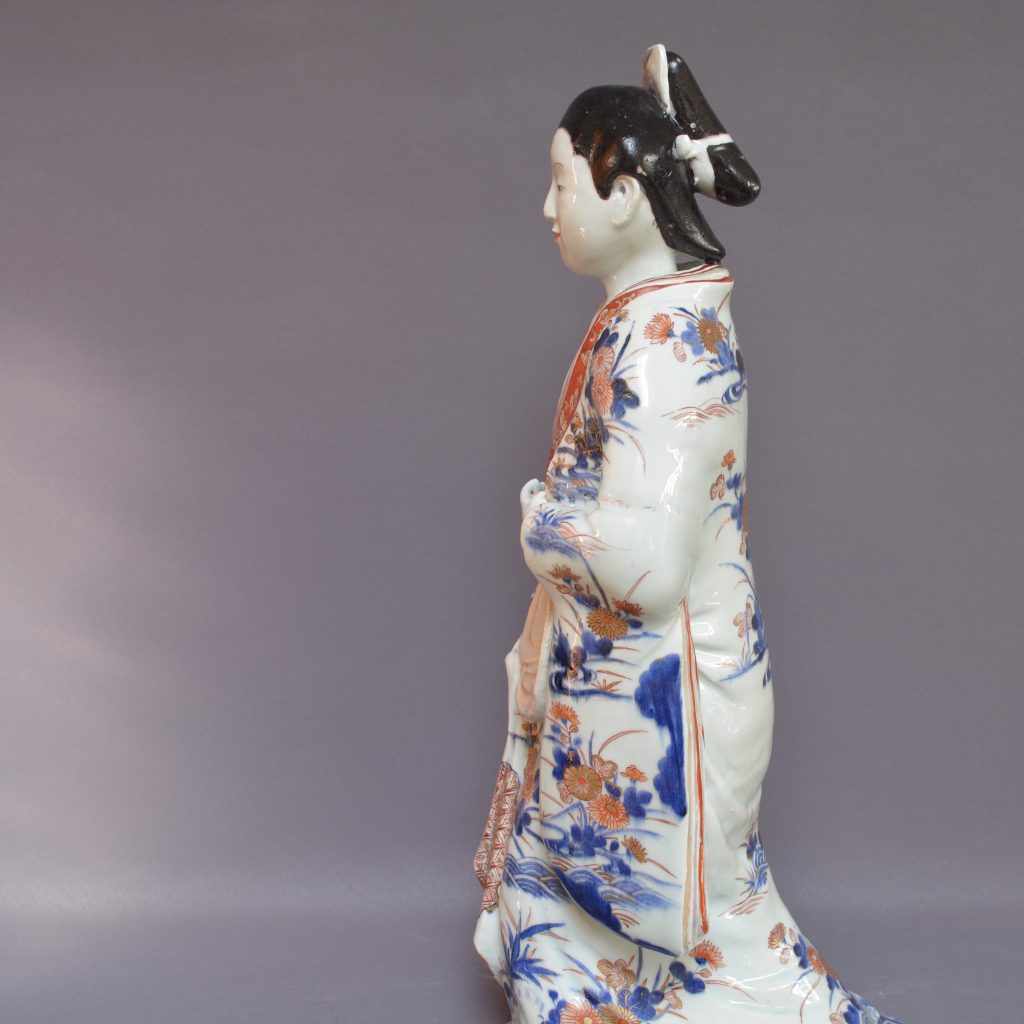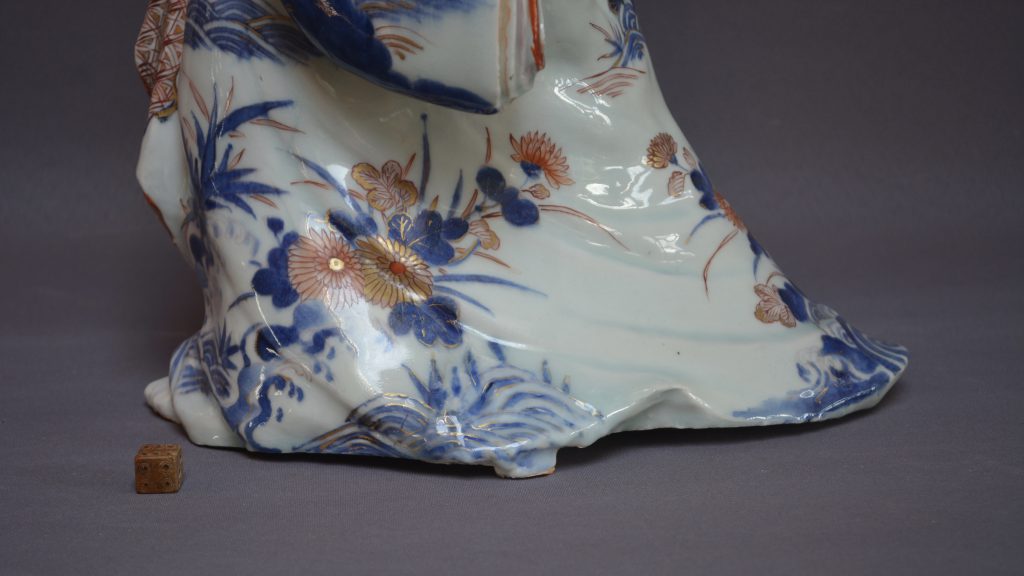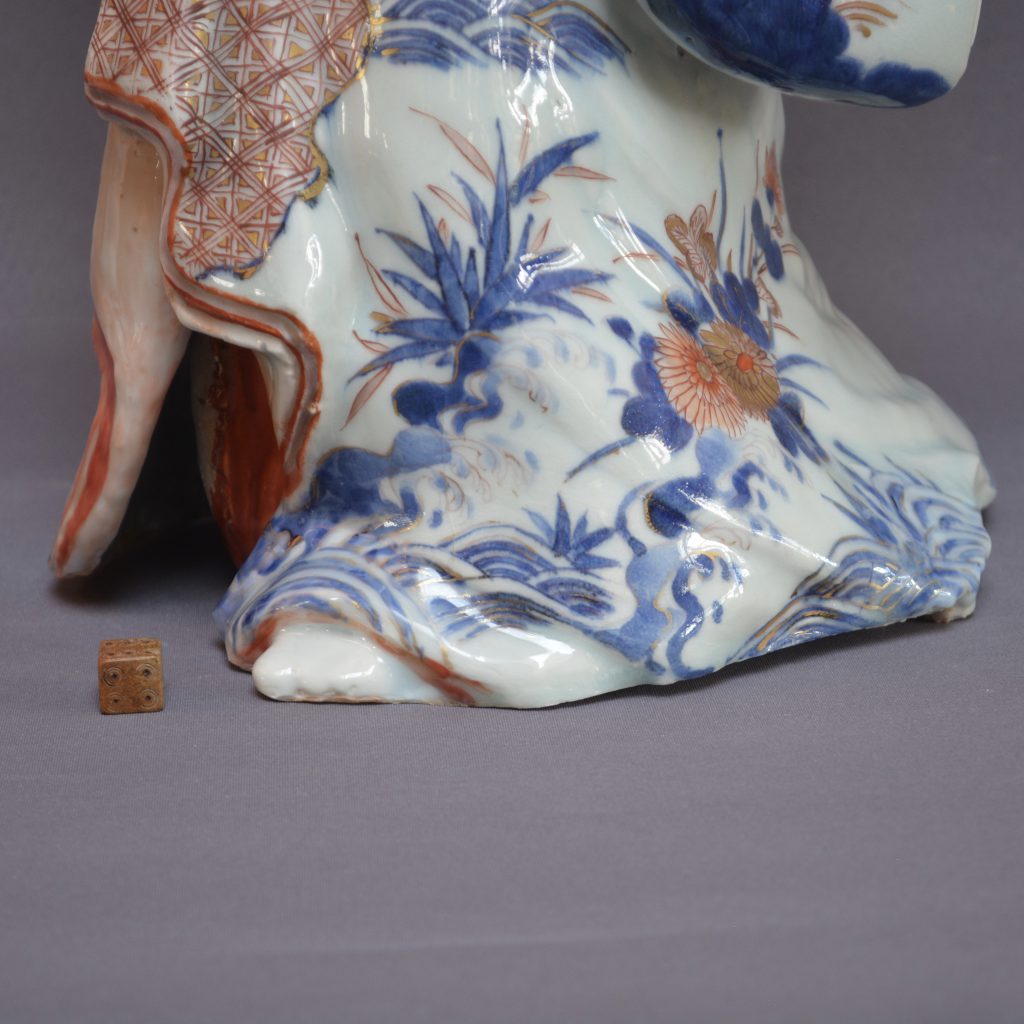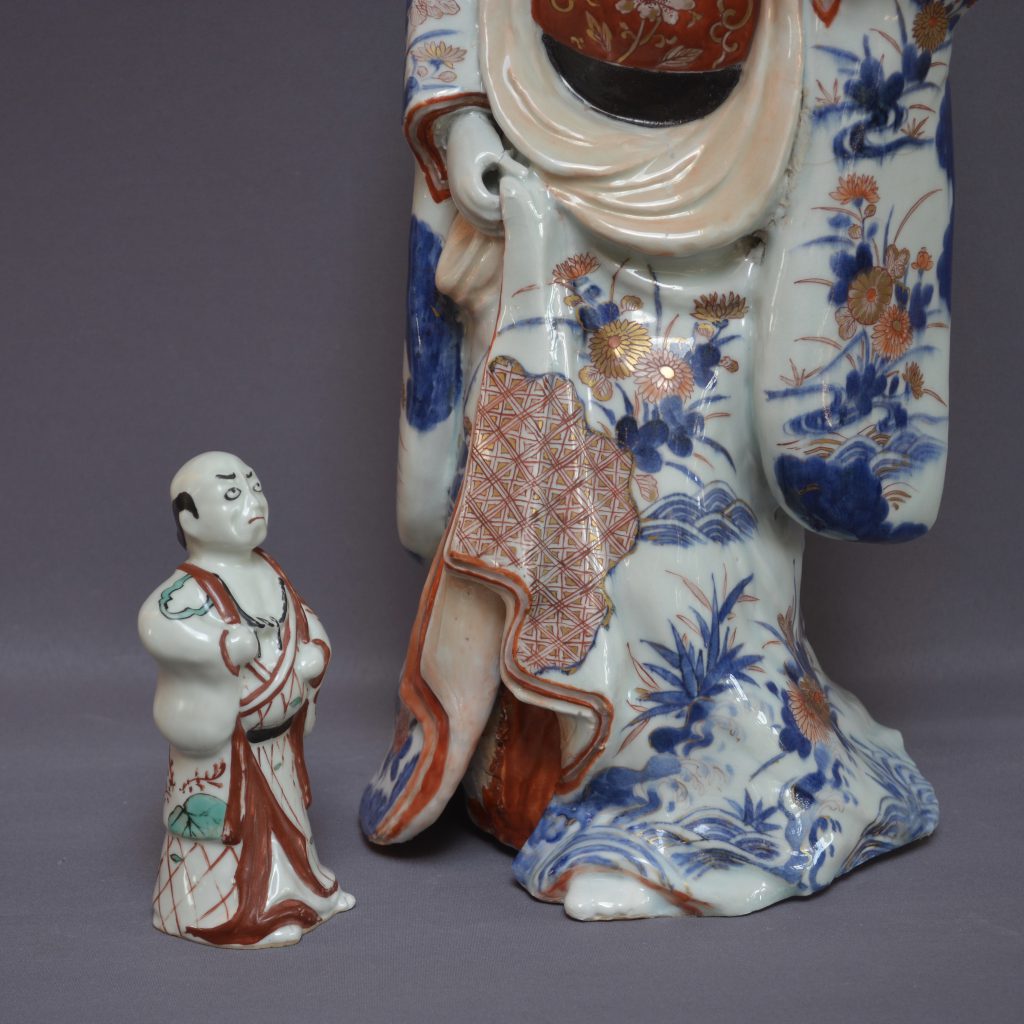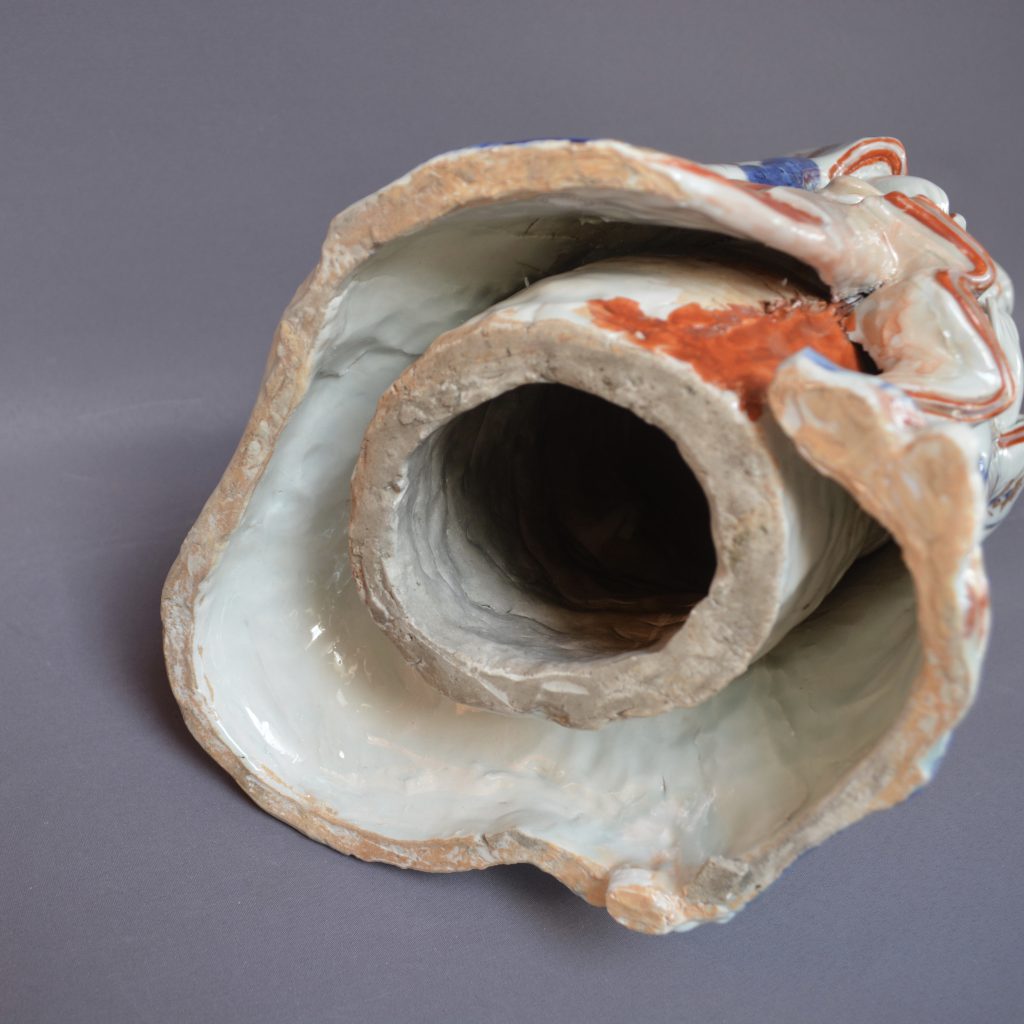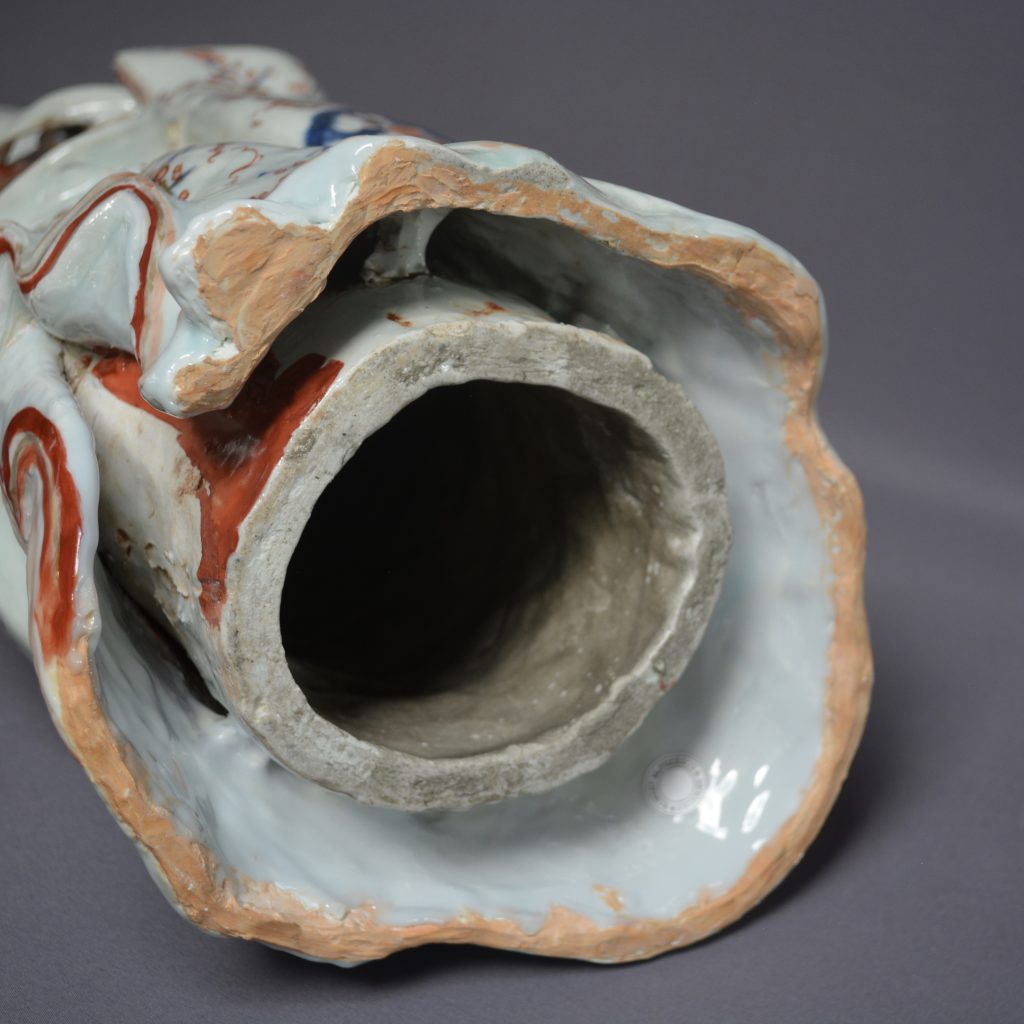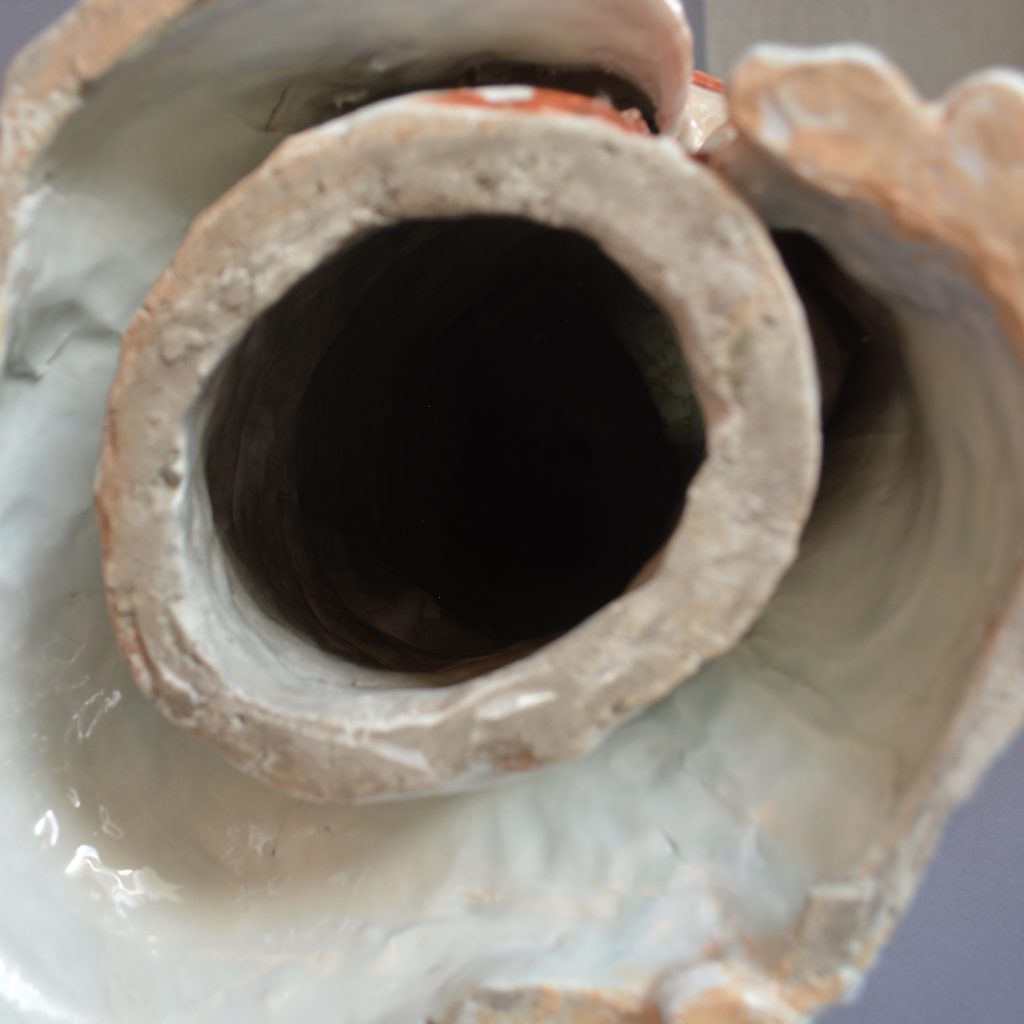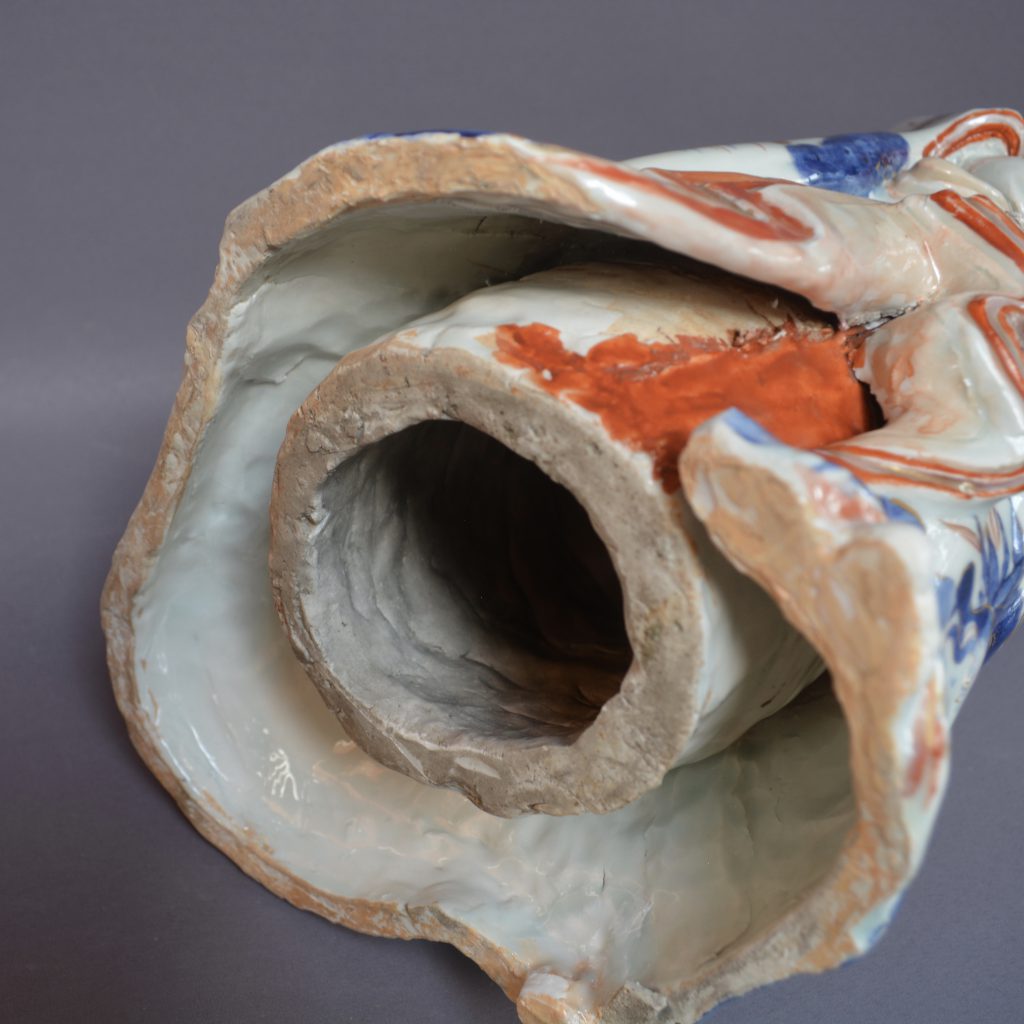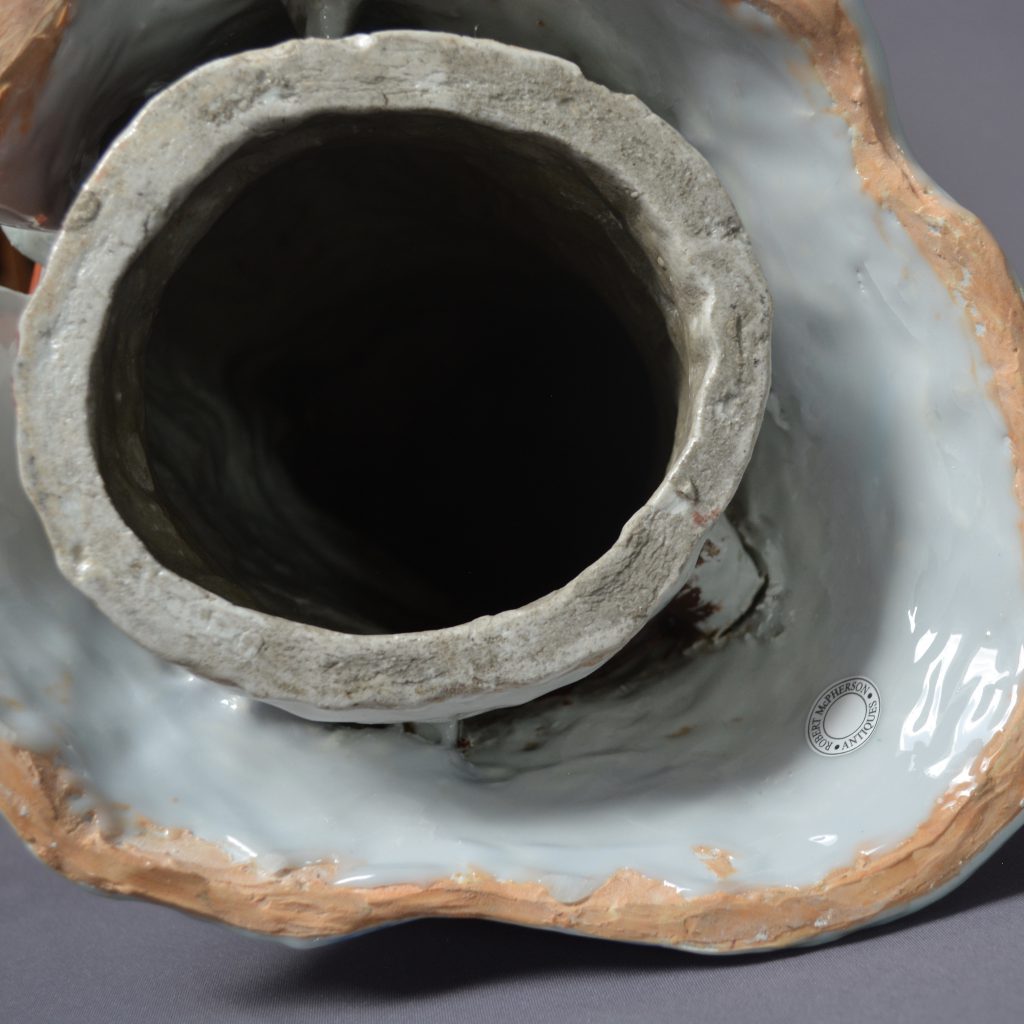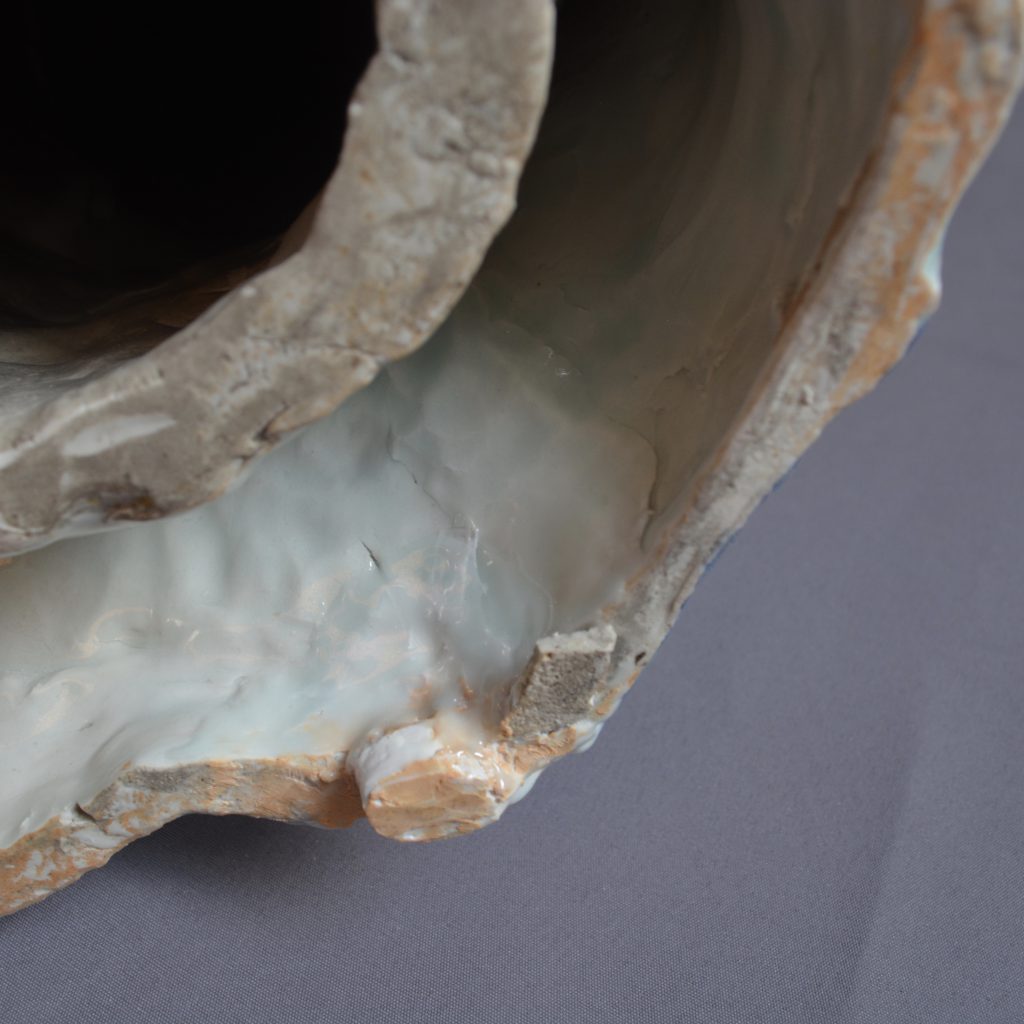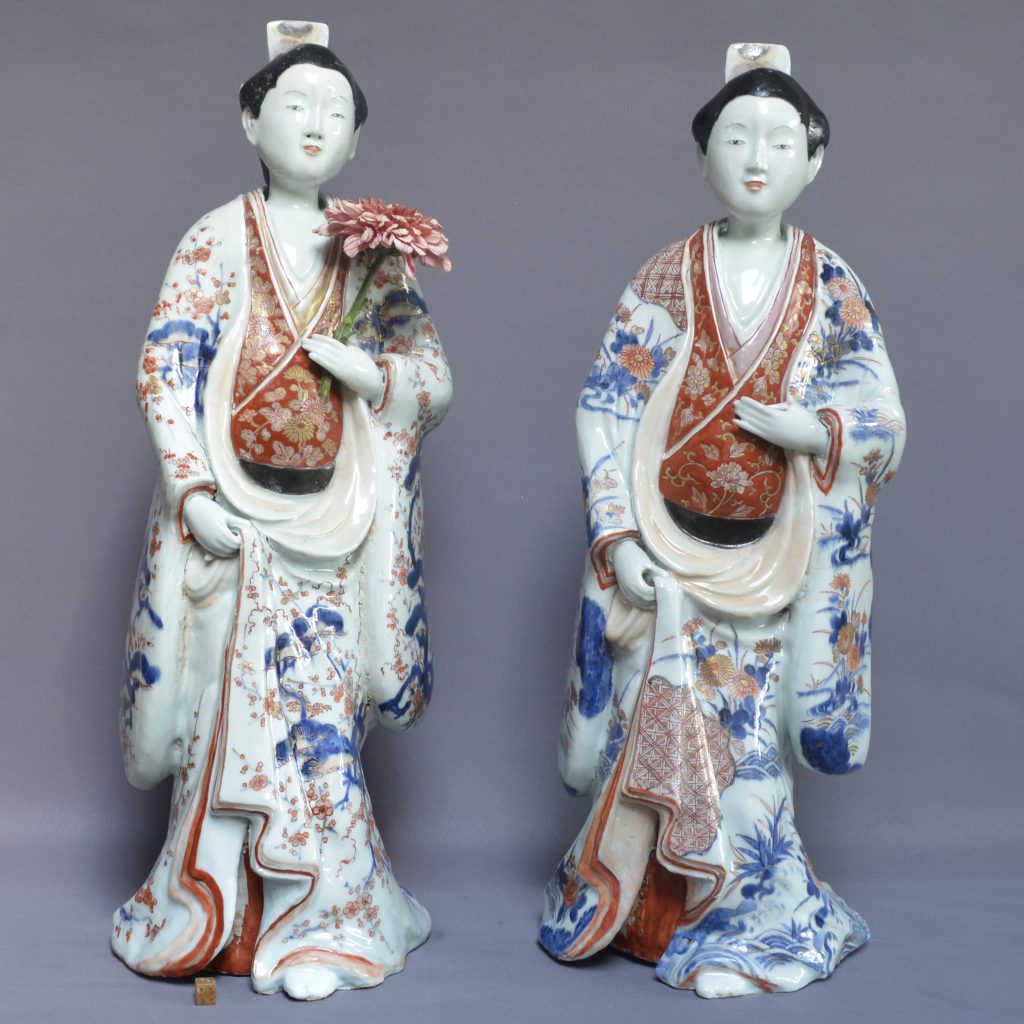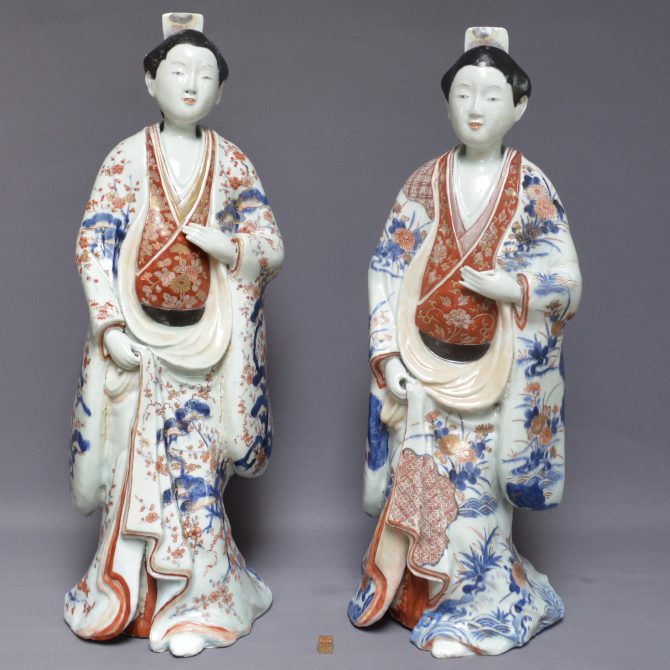
A Pair of Fine and Rare Japanese Porcelain Bijin, Arita Kilns, Early 18th Century.
Pair of Fine and Rare Massive Japanese Porcelain Imari Bijin (Beauties), Arita Kilns c.1700 – 1730. It is very unusual to find such an elaborately executed pair of Japanese porcelain Bijin. The present examples are particularly sculptural and ambitious in their concept, not just in terms of size but all in terms of modelling. For example, the porcelain rendering of the kimono opens to reveal the Kosode (inner kimono), normally this would be indicated by painted decoration alone, not by modelling. The sleeves of the Kimonos at the back are sculpted to have a space, giving a feeling of depth and therefore enforce a sense of reality. The lower backs of the Kimonos project a long way behind the figures, adding to the feeling of movement and at the same time affording the figures more stability. A porcelain cylinder has been used to support these large heavy figures during the production process and beyond, where the cylinders are visible, they have been painted in an iron-oxide red to give the illusion of clothing.
18th Century Arita porcelain Bijin, as well as the earlier Kakiemon Bijin, often differ from one figure to another in terms of decoration, in other words they are perhaps not seen as a pair as defined by ridged European standards. One of the Bijin’s Kimono is decorated with a flowering cherry tree intertwined with a pine tree, since ancient times pine (matsu) has been revered as a symbol of long life and good fortune. The Japanese word for flower (hana) often refers specifically to cherry blossom. Flowering cherry is normally tied to other elements in nature, for example the start of Spring, flowing rivers or the darkness of night. Her Kosode (inner Kimono) is decorated with chrysanthemum. The other figure’s Kimono is painted with chrysanthemum (makie) with flowing water. The flowering plants express superior character, the light of the sun, long life and virtue. Her Kosode is decorated with peony, a symbol of nobility.
Both Bijn wear clothes that hide their shape, these models are in no way provocative and leave everything to the imagination. Well perhaps they hint at something, the large Kimonos are, after all, semi-undone at the front. Only the straight black obi (belt) tied at their waist around their Kosode (inner Kimono) and their elegantly tied hair with upright combs in the Gosho Mage style give a feeling of formality and decorum. It is thought that about 2/3rds of the Japanese urban population were male. Depictions of such Bijin, or beautiful ladies, were popular in Japan at this time. Ukiyo Ningyo (dolls of courtesans) became popular as well as the new art form of ukiyo-e, or “pictures of the floating world.” Ukiyo-e woodblock prints showed various aspects of the pleasure quarters that flourished during this period, including courtesans and onnagata, male kabuki actors who played female roles. The fashions of the day were typically shaped by the workers of the pleasure quarters, and this figure’s attire is probably also styled on such a model.
Christian Jorg explains in his excellent book “The function of these large figures is unclear. They were probably considered as exotic, decorative items in the West, and must have reminded people of the Chinese ‘Long Eliza’ so often depicted on Kangxi export porcelain. The first shipment to the Netherlands in 1659 already included ‘100 various dolls” (‘Fine and Curious, Japanese Export Porcelain in Dutch Collections’). It seems this shipment and a subsequent delivery in 1665 were all small figures, therefore most figures would been bought privately as part of the ‘private trade’ concession. This makes sense as most Chinese porcelain figures in the 18th century was private trade. Jorge goes on to say “Amazingly, standing figures were rarely copied in European ceramics. In fact, only one small faience example is known thus far”. This is also illustrated in ‘Fine and Curious, Japanese Export Porcelain in Dutch Collections’ and can be seen in Groningen.
Imari Porcelain is the European collectors` name for a type of Japanese Porcelain made in the town of Arita, in the former Hizen Province, north western Kyūshū, and exported via the port of Imari, specifically for the European Export trade. Imari was simply the trans-shipment port for Arita wares, no porcelain was made there. The kilns at Arita formed the heart of the Japanese Porcelain industry, which developed in the early 17th century. Although Imari originating in Japan the tern is used to describe a whole range of ceramics from all over the world, they are all linked by their bright distinctive palette of blue, red and gold. The cobalt that created the blue was added prior to glazing, while the iron-oxide red and the gilding were applied after glazing.
SOLD
- Condition
- Not surprisingly both figures have with some restoration, this has been done to an extremely high standard - the Bijin with the Prunus kimono has some over-paintings and repair around the whole lower section of the kimono. In some places this extends up to 7 cm high. It is difficult to work out if there is missing sections or see any damage but a strong torch shows light through in all but the thickest parts. One finger and the tips of the others partly restored. The hair comb is restored. The figure with the chrysanthemum kimono has two large sections to the back, where the kimono projects out, re-stuck and restored. There are two sections of the lowest part of the kimono restored c.9 x 2 cm and 5 x 2cm, these appear to be missing areas. The head has been restored along one side of the nose and a small area around it. The head has been re-stuck, the hair comb is restored. One finger is restored as well as two finger tips have been restored. Both figures has restoration to the projecting foot.
- Size
- The Bijin with the Chrysanthemum kimono - 57.3 cm (22 1/2 inches). The Bijin with the Prunus kimono - 59.6 cm (23 1/4 inches).
- Provenance
- N/A
- Stock number
- 25628
- References
- For an early 18th century Japanese porcelain Bijin model of a far more basic type, 48.5cm high, now in the Groninger Museum (1960-10) high, also dated c.1700-1730 see : Fine and Curious, Japanese Export Porcelain in Dutch Collections (Christian J.A. Jorg, Hotei Publishing, 2003. ISBN 90-74822-16-9. Page 278, plate 350. For a pair of very closely related Japanese porcelain Bijin figures, for sale by A & J Speelman in London, dated to the late 17th or early 18th century, see http://www.ajspeelman.com
